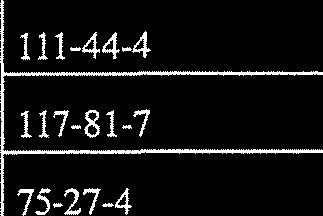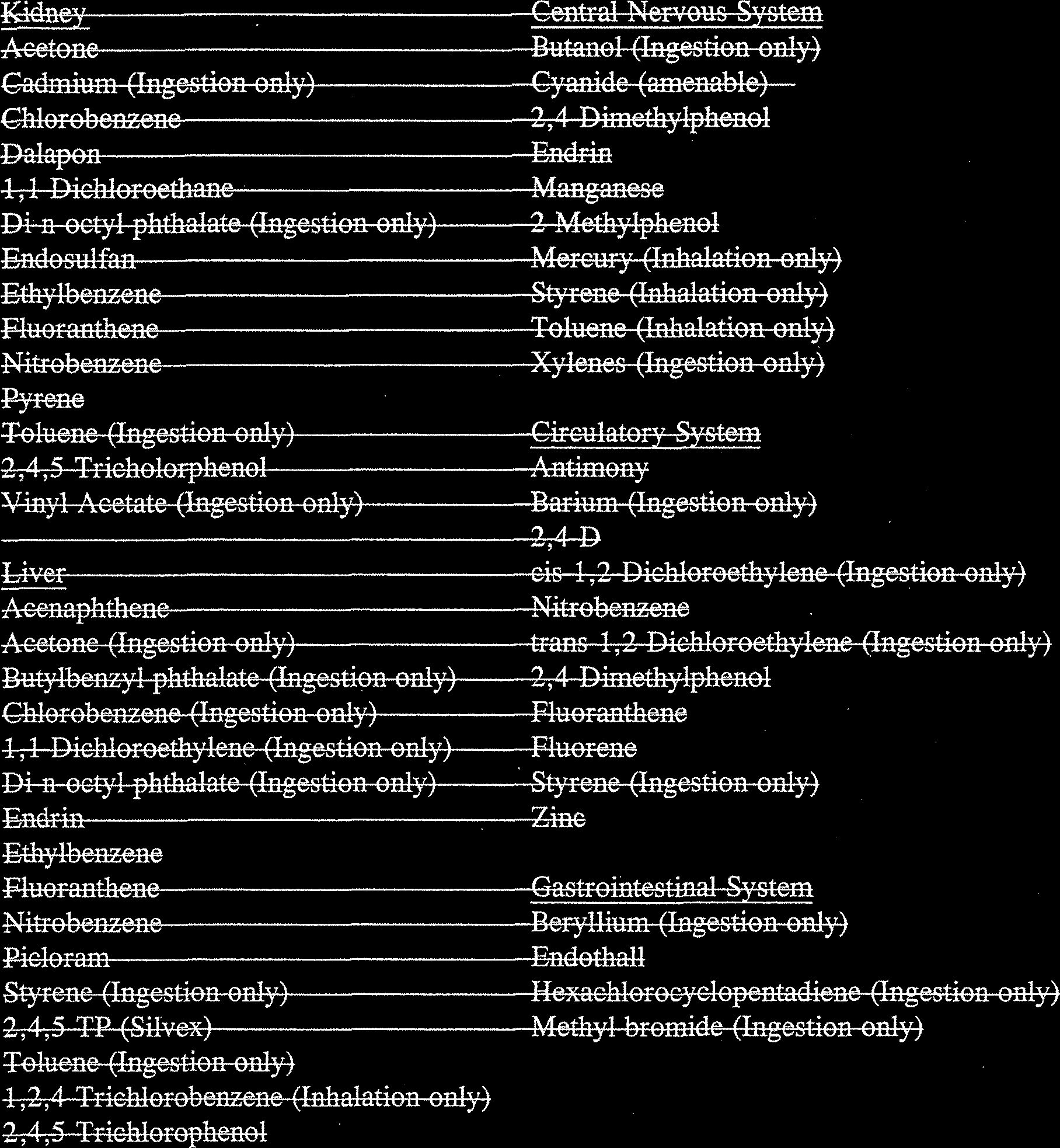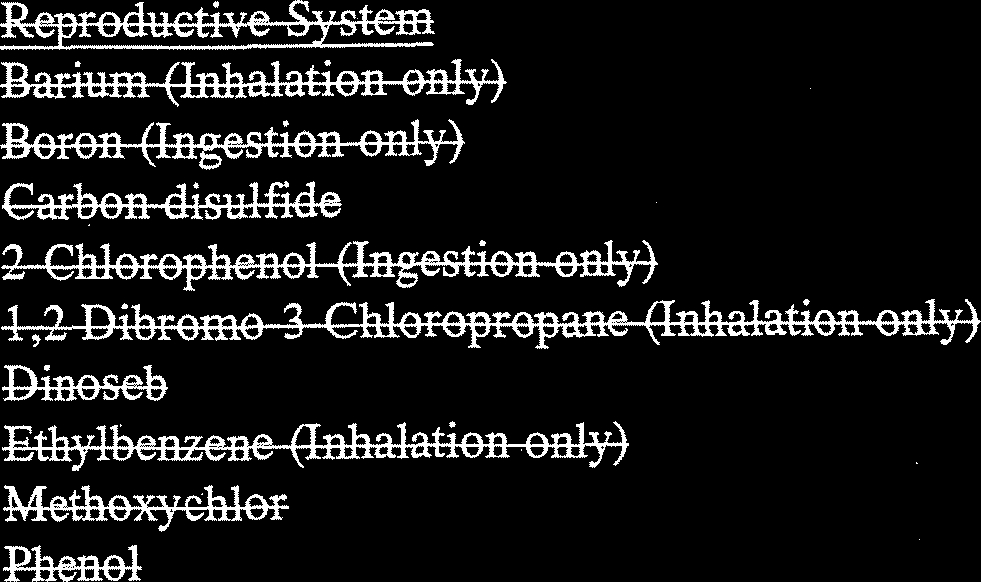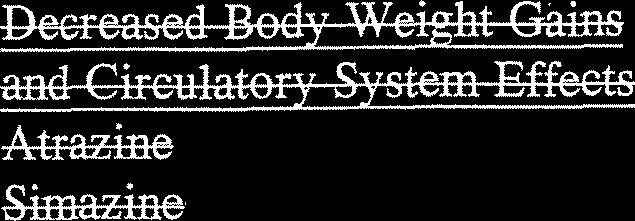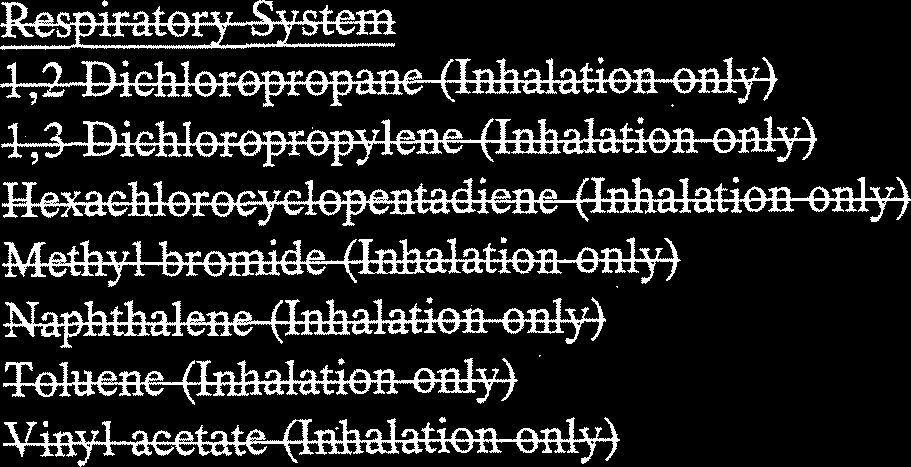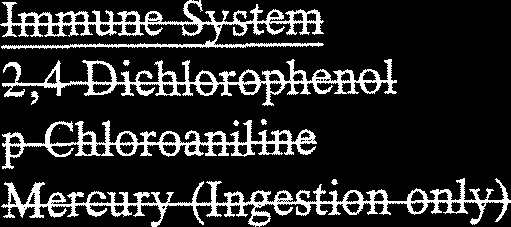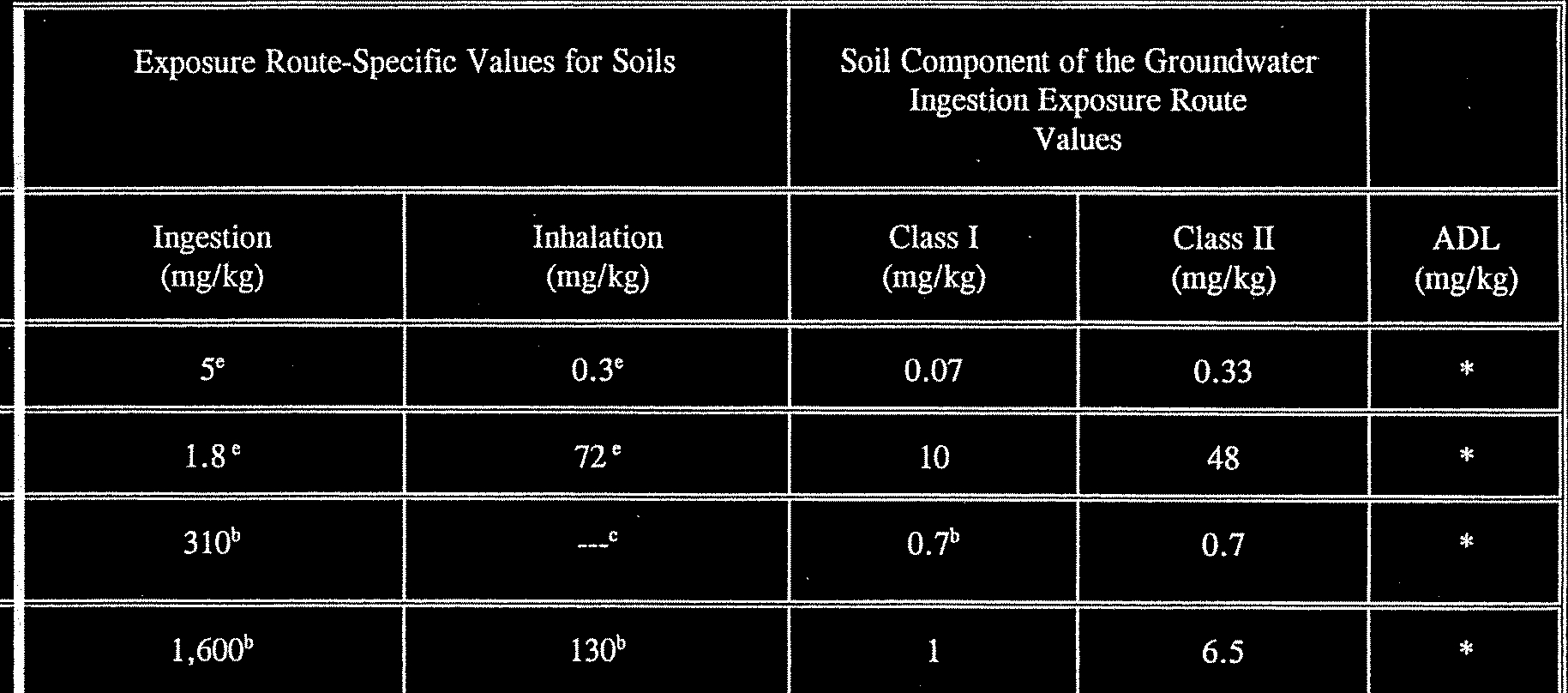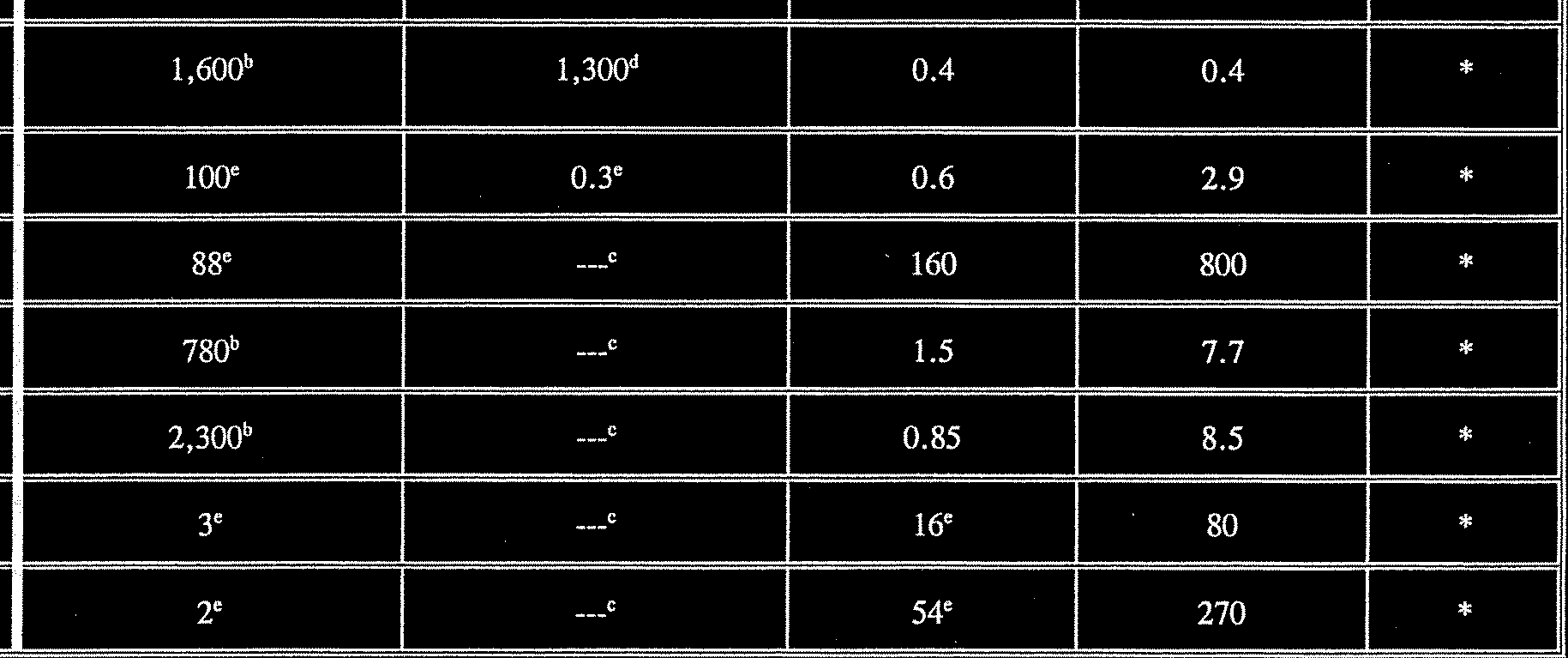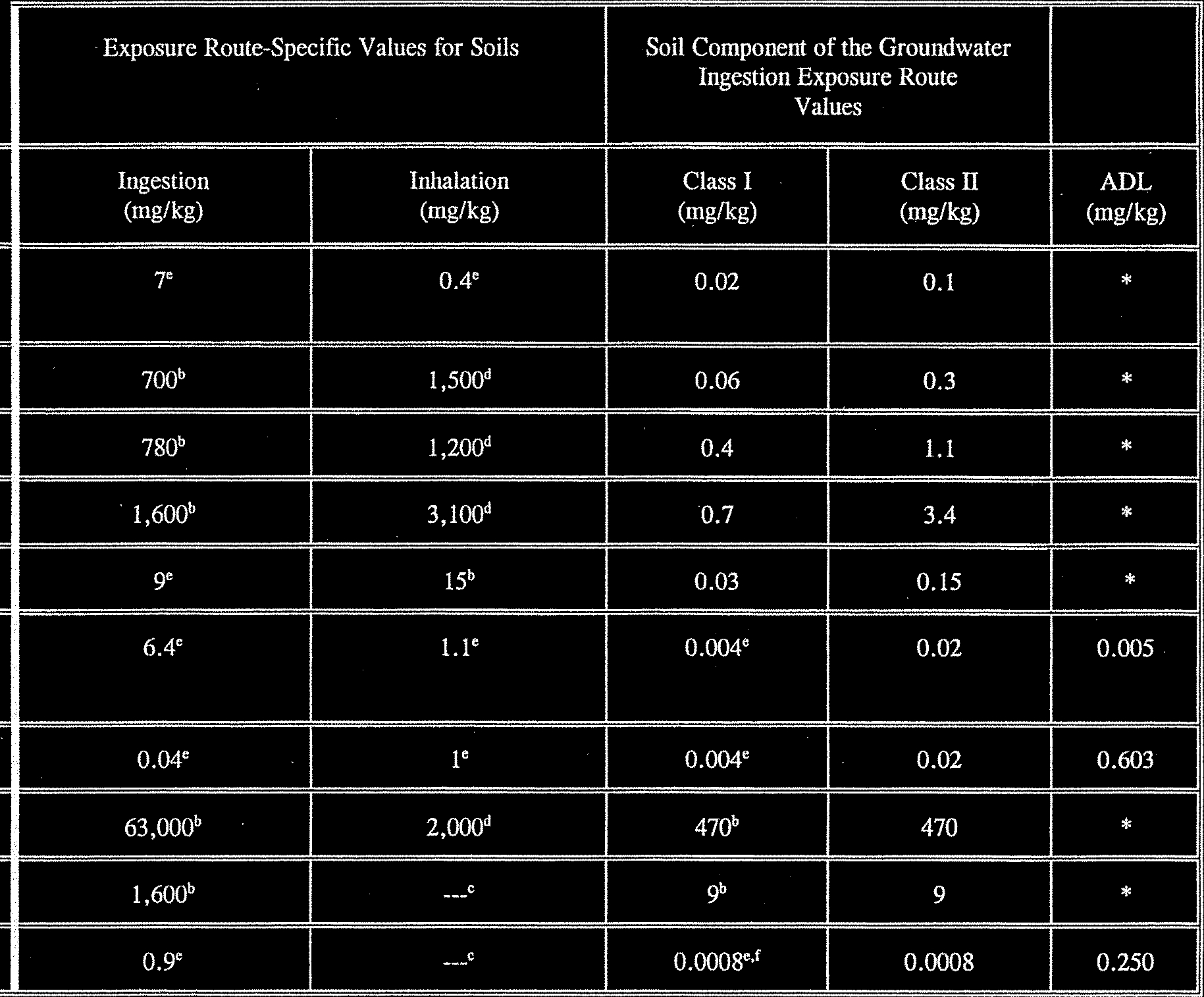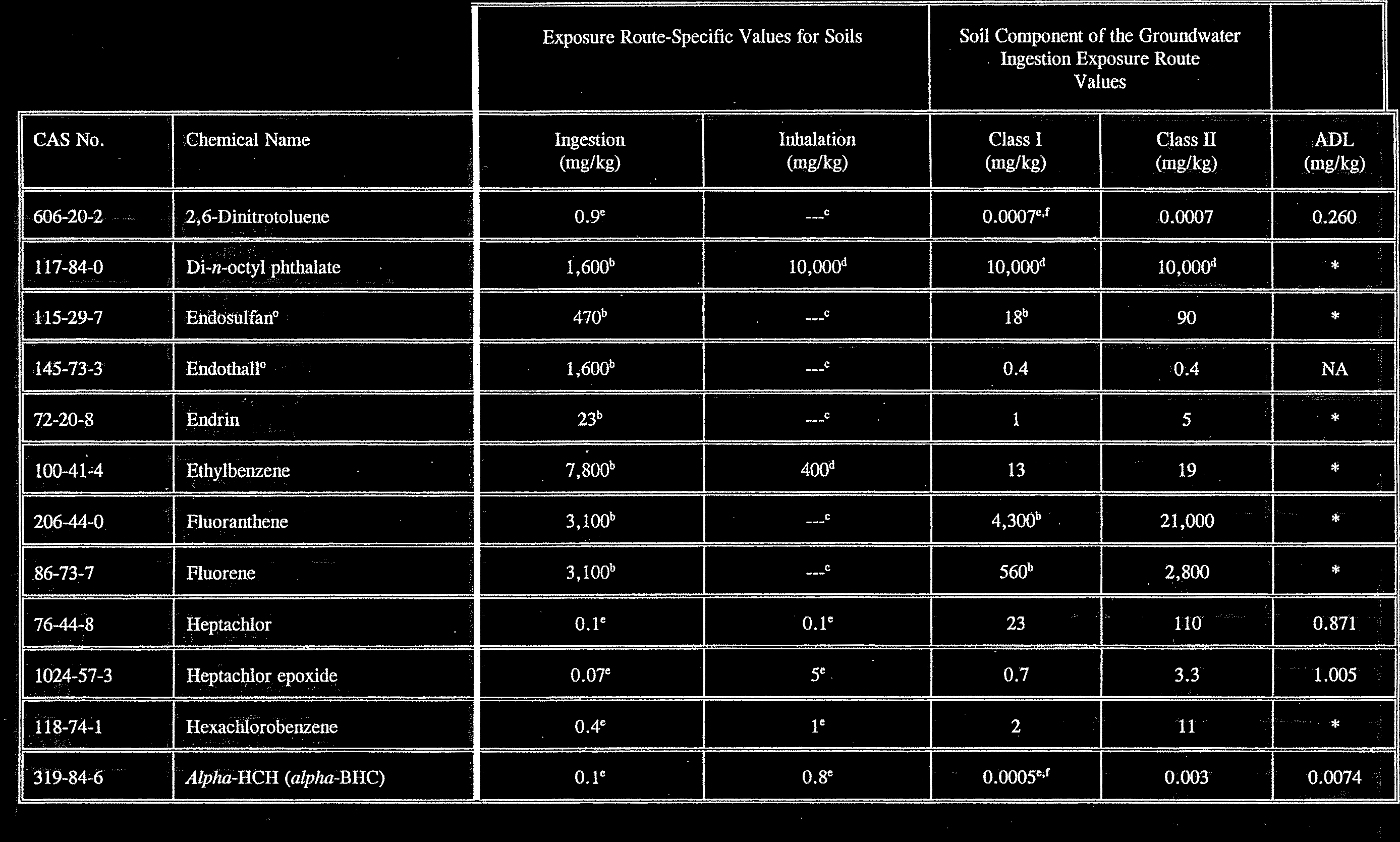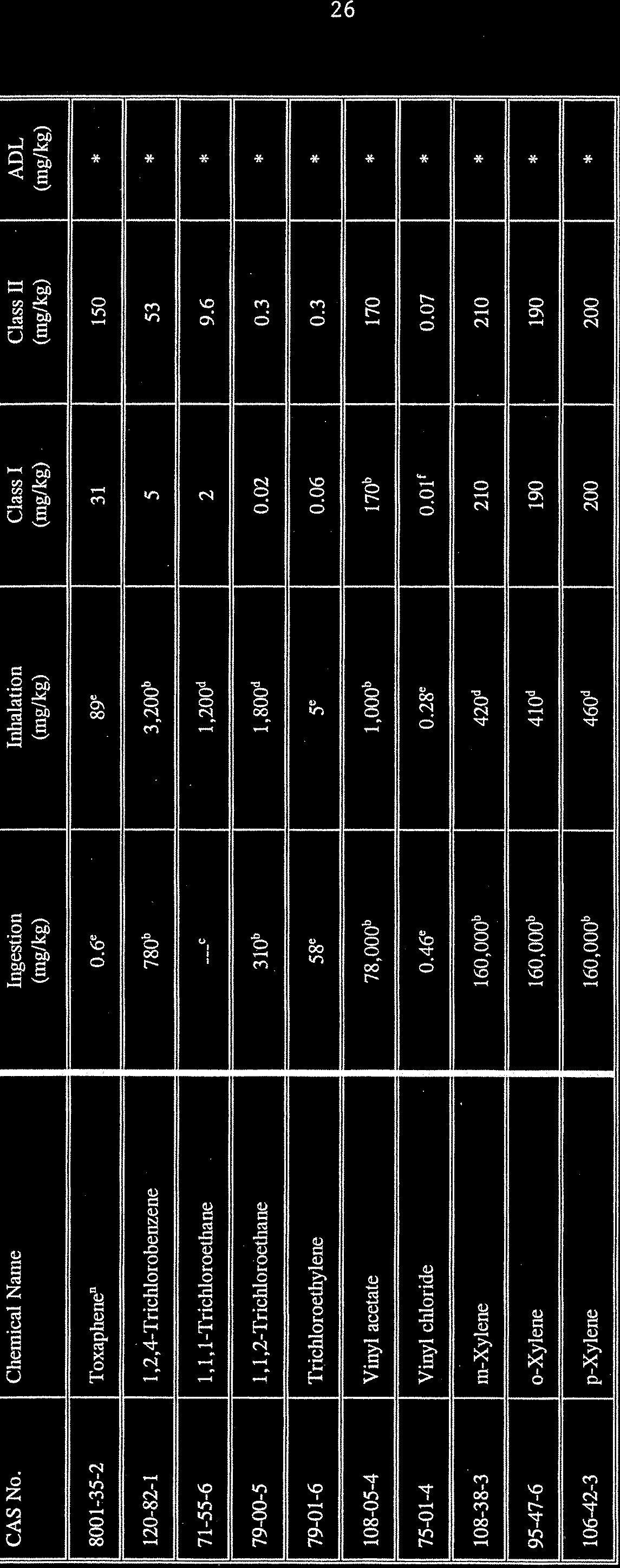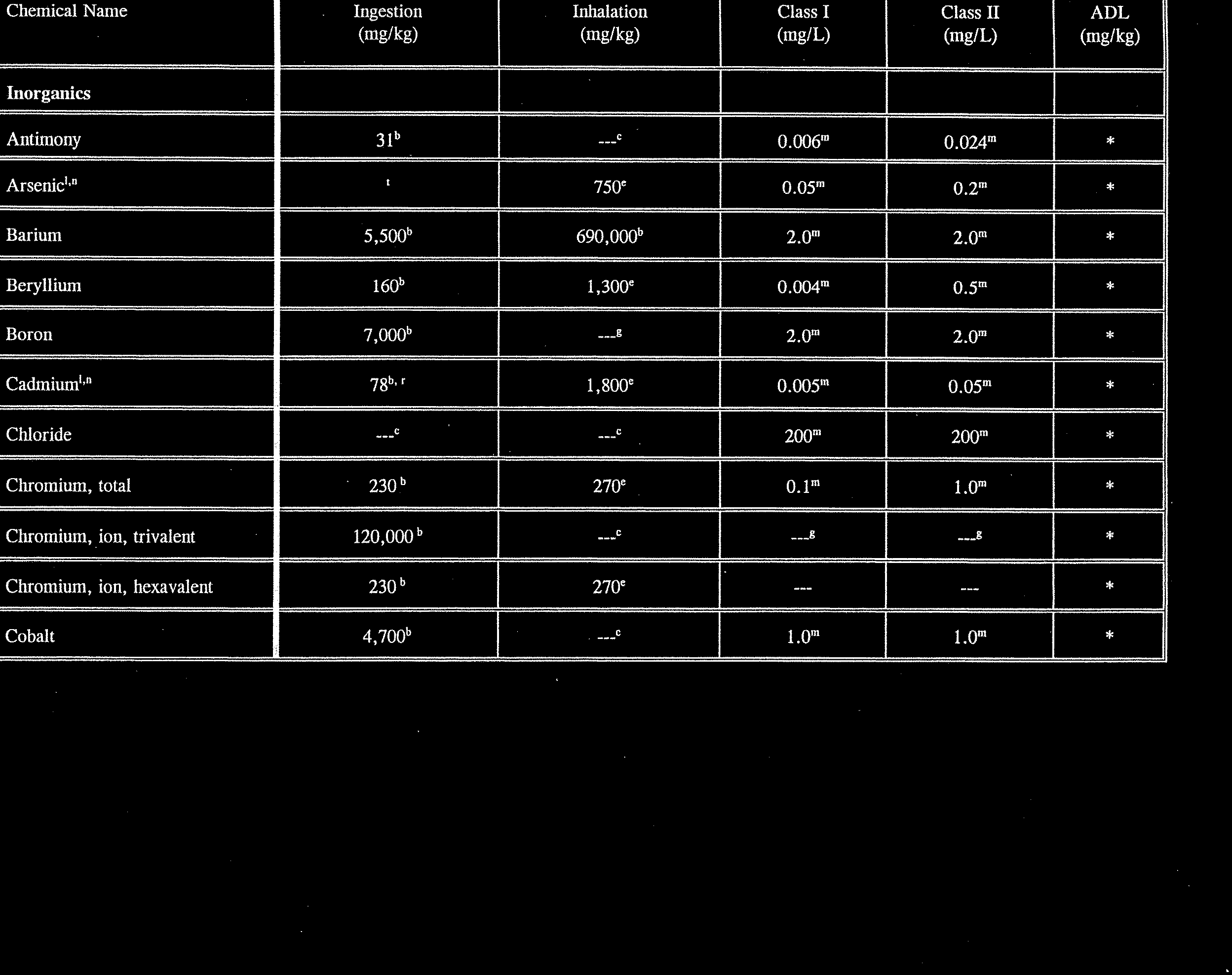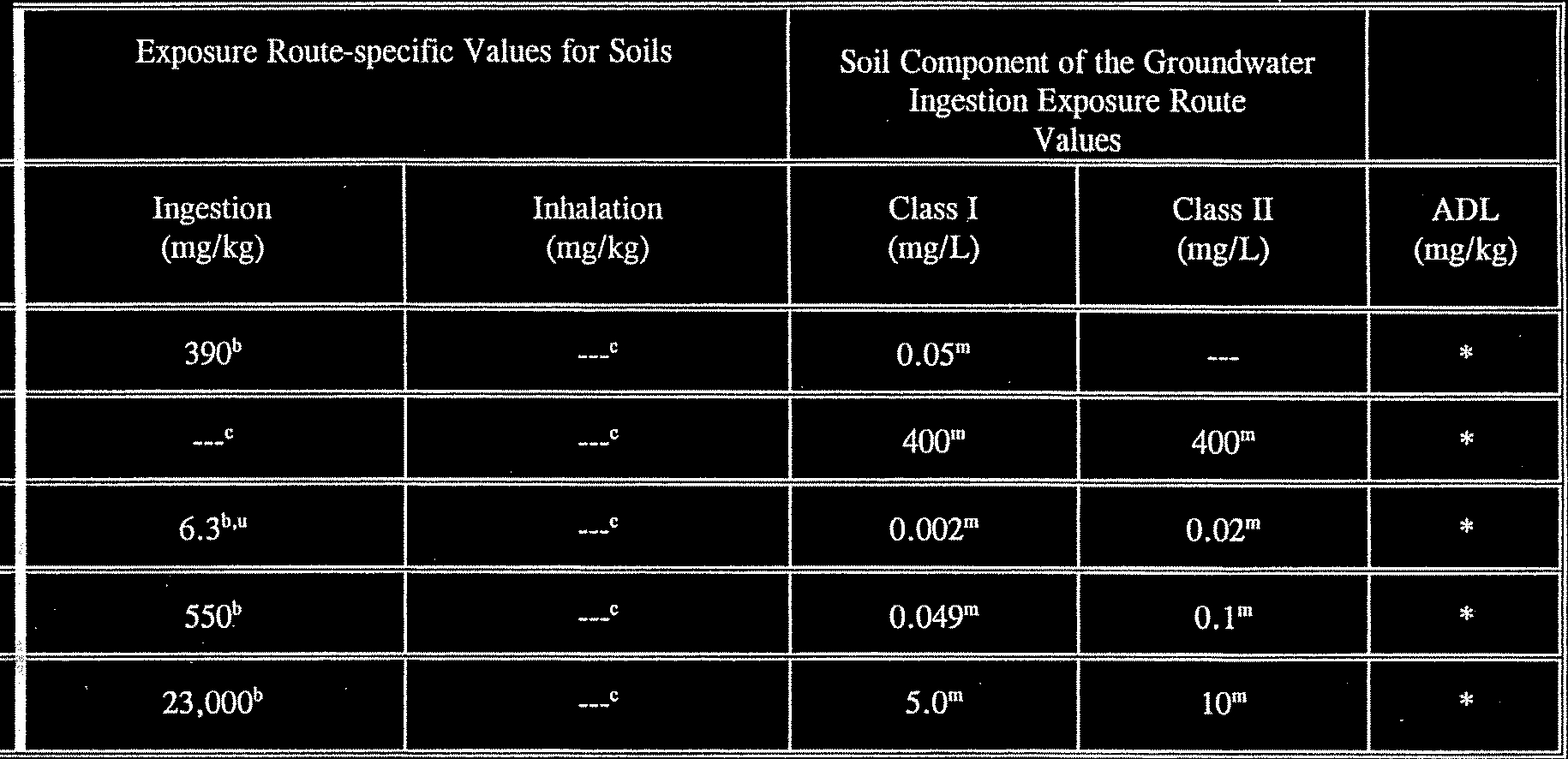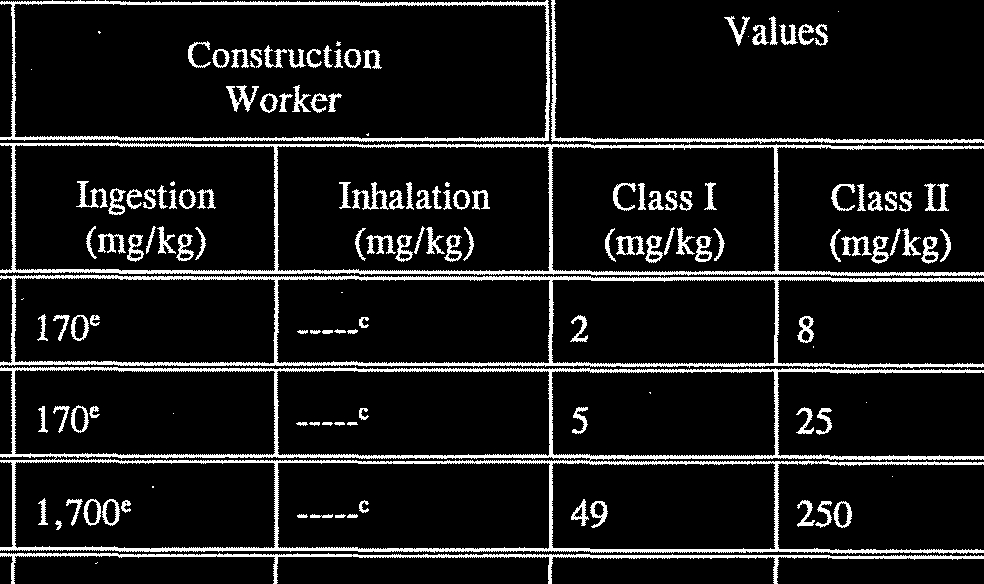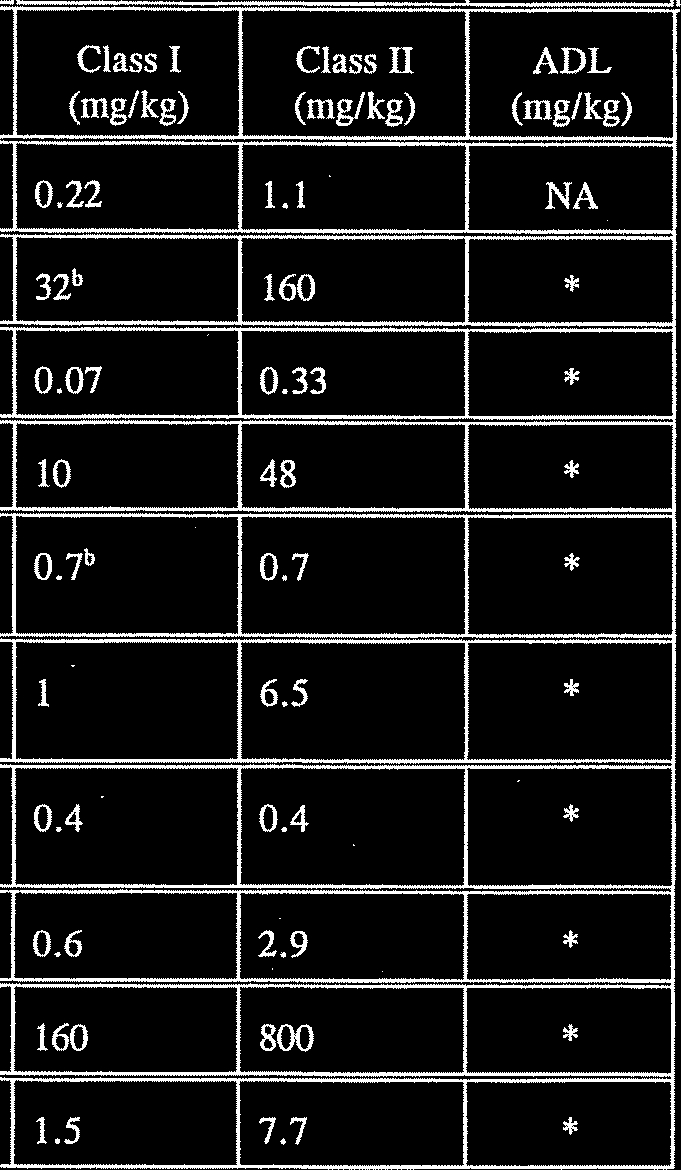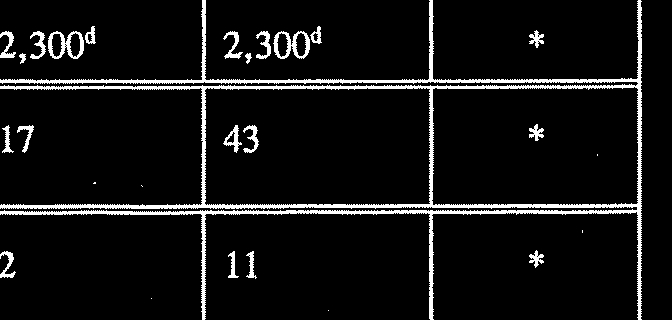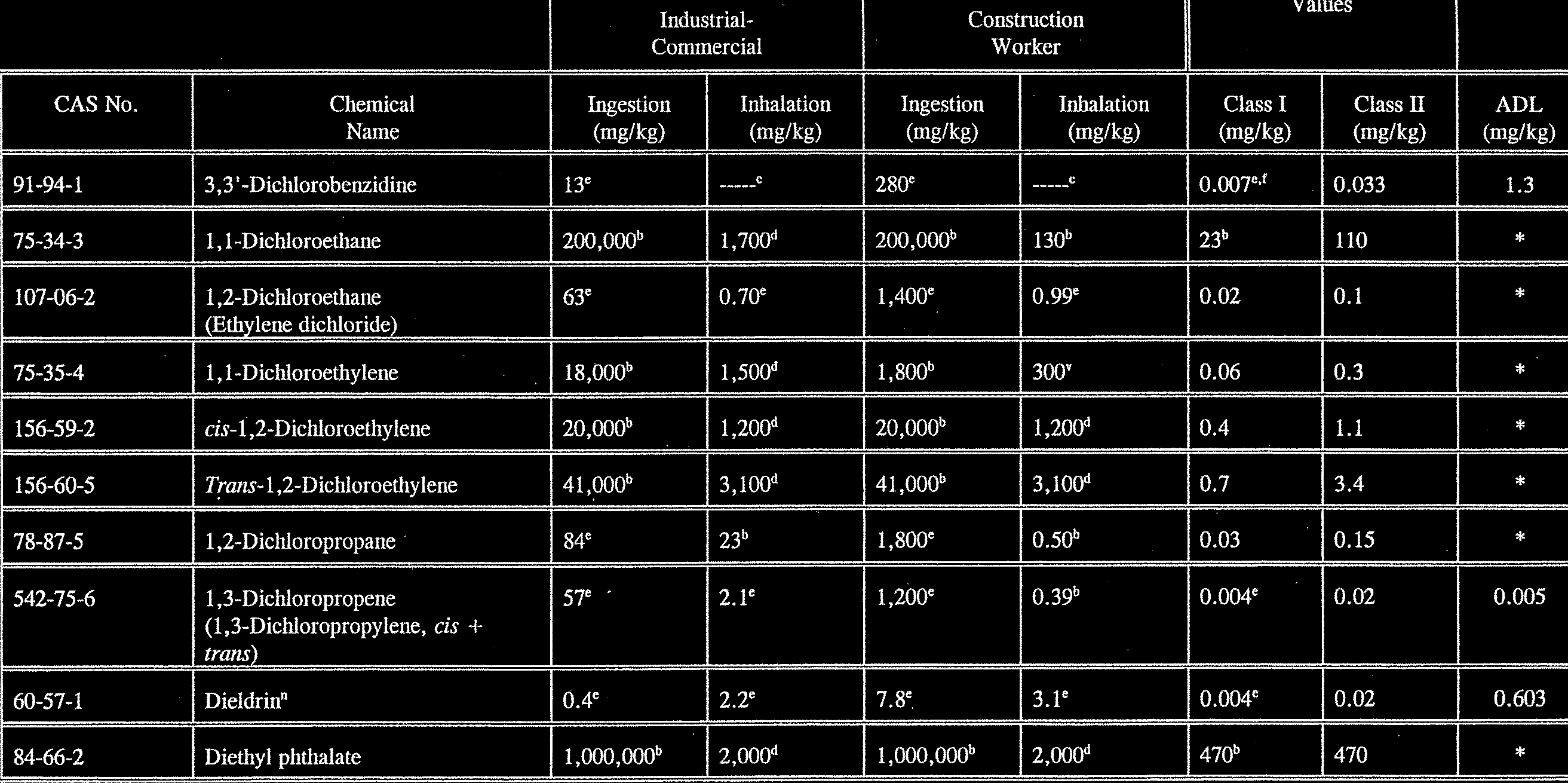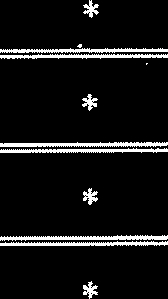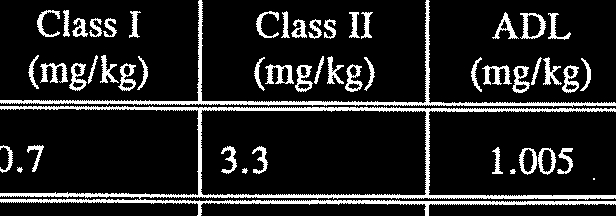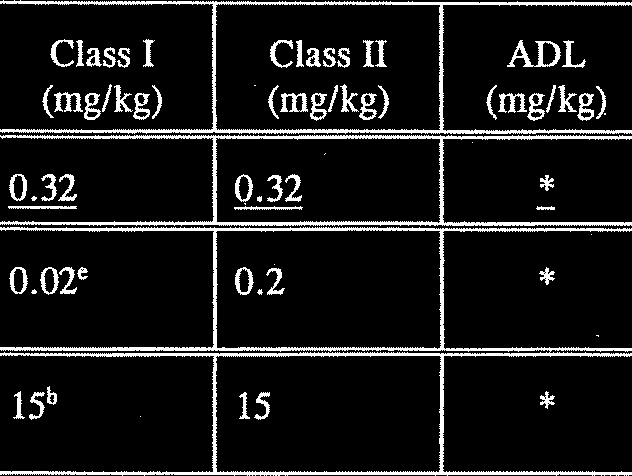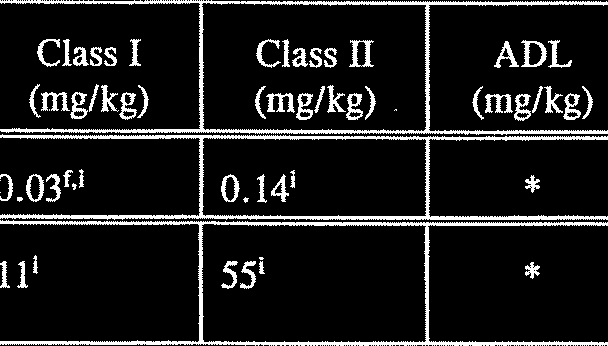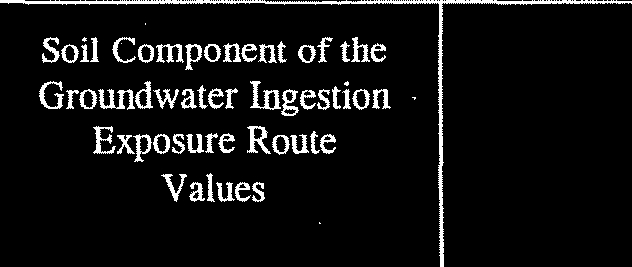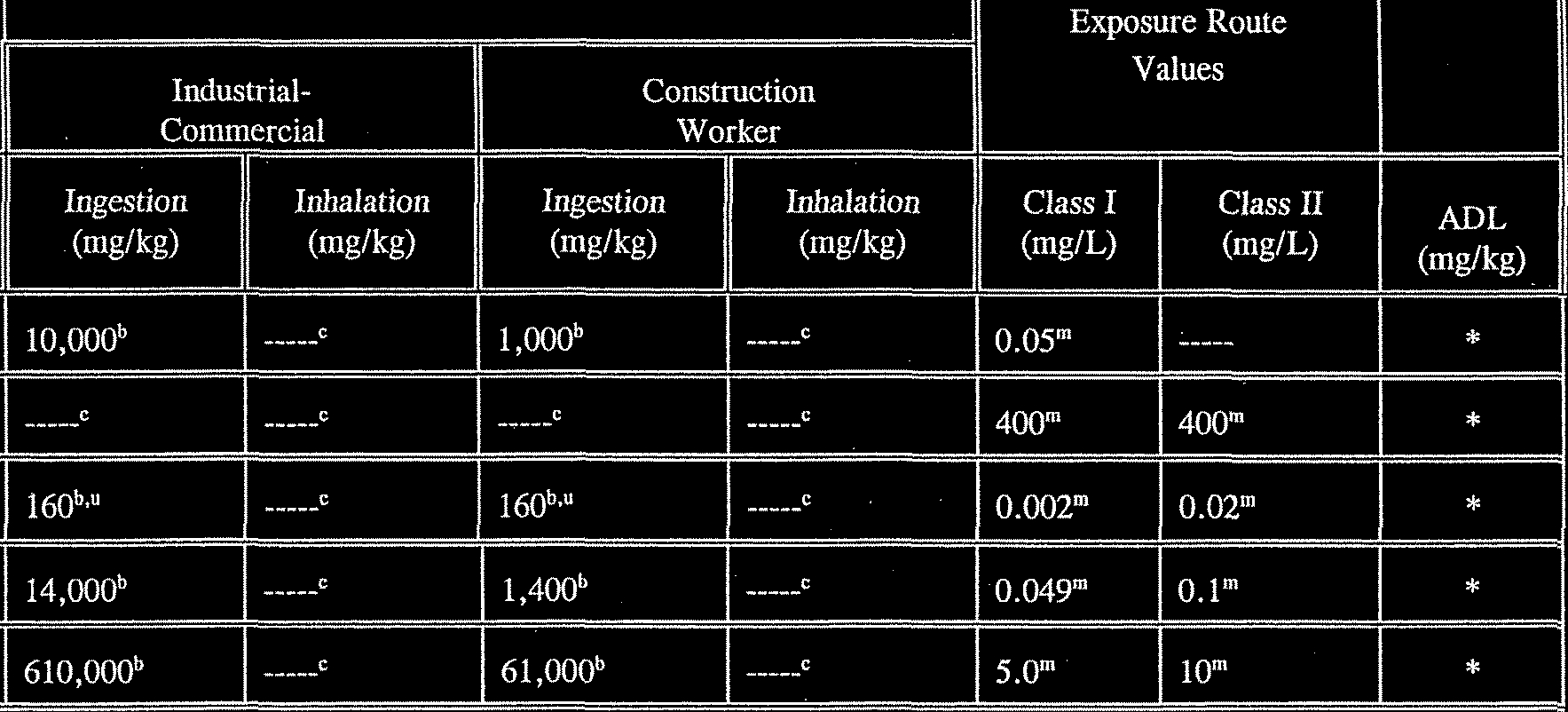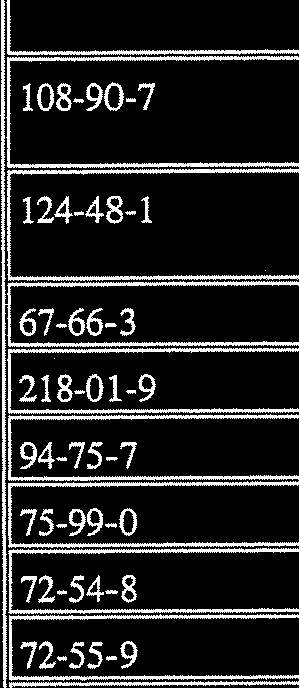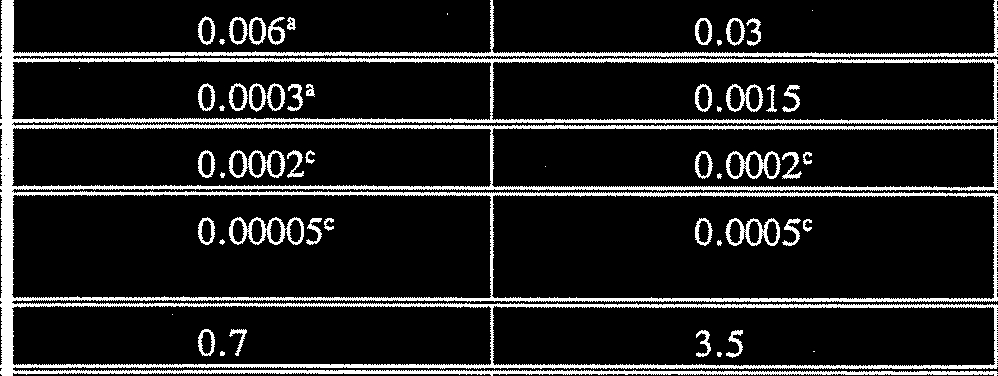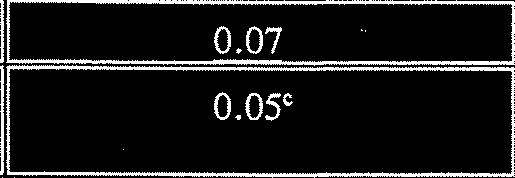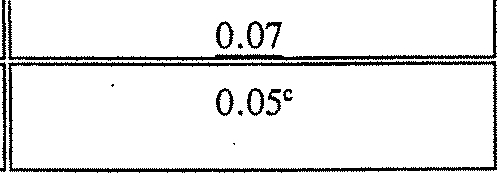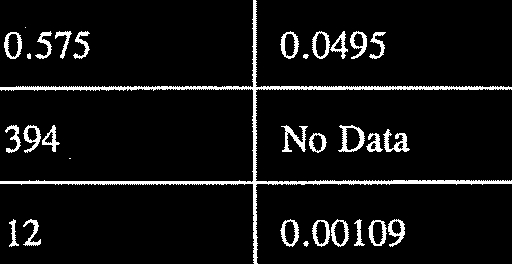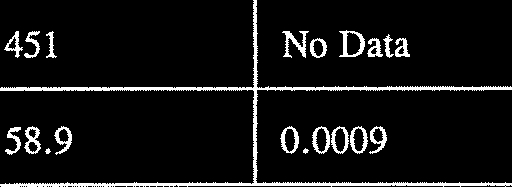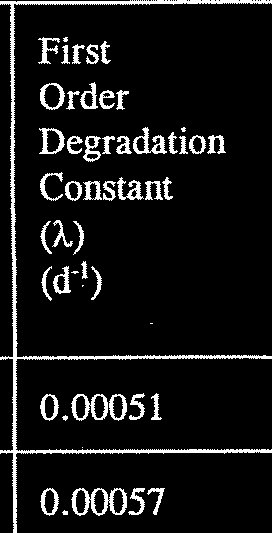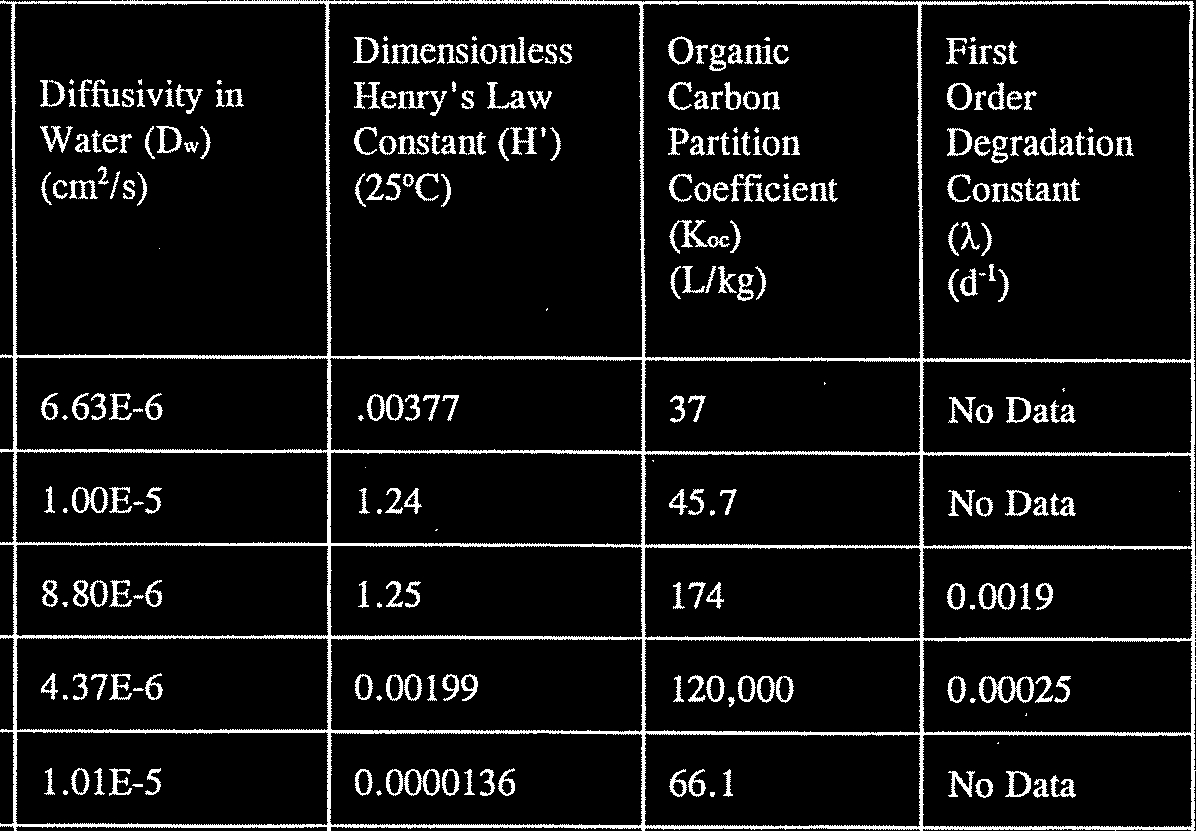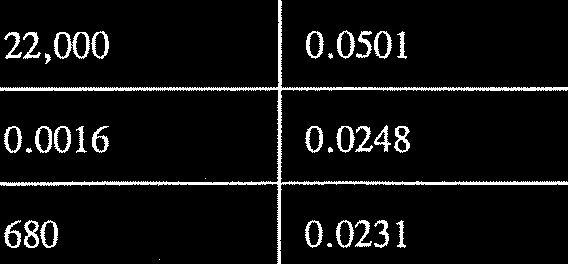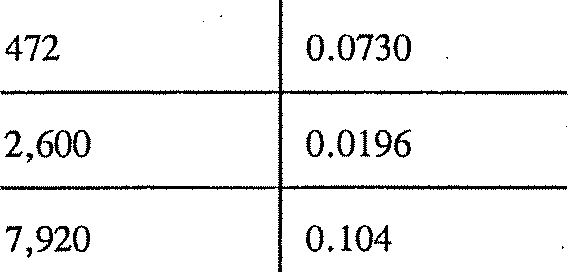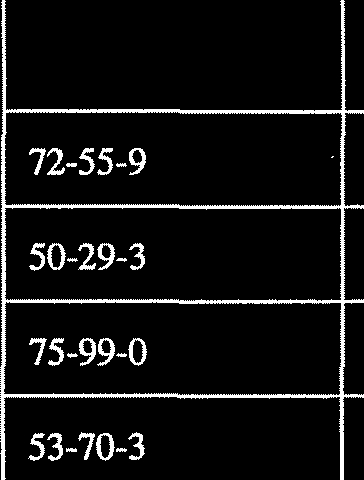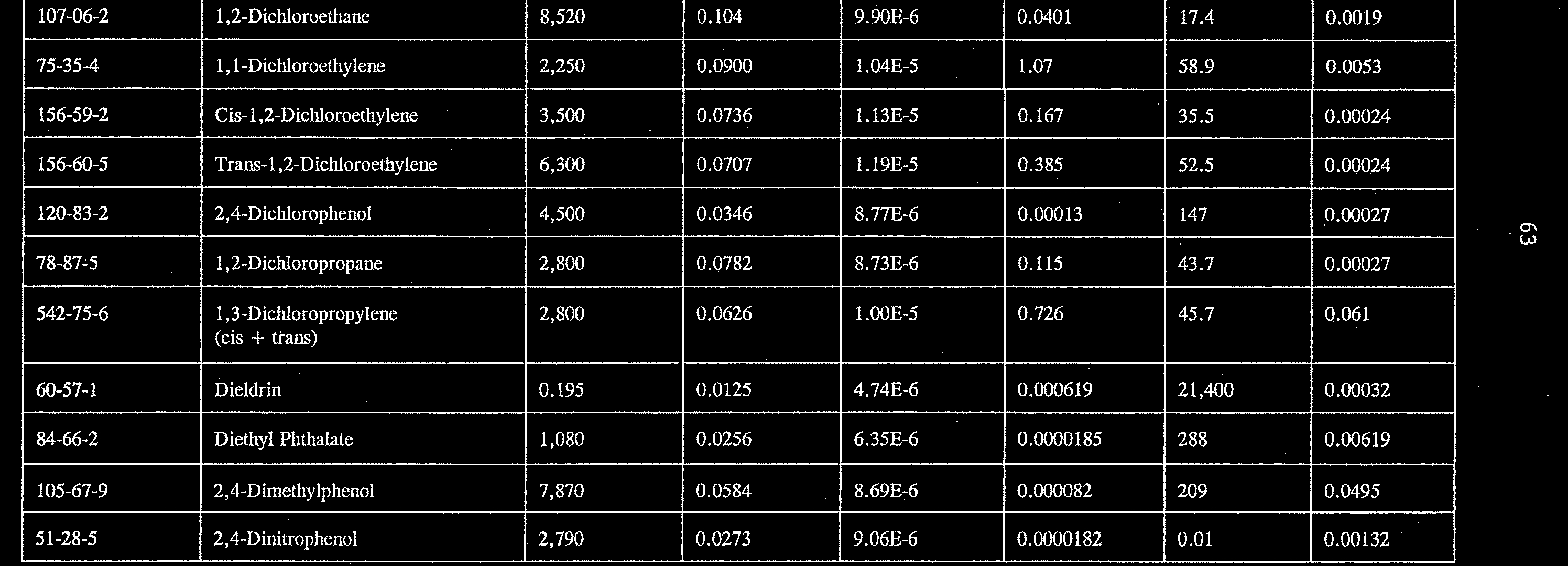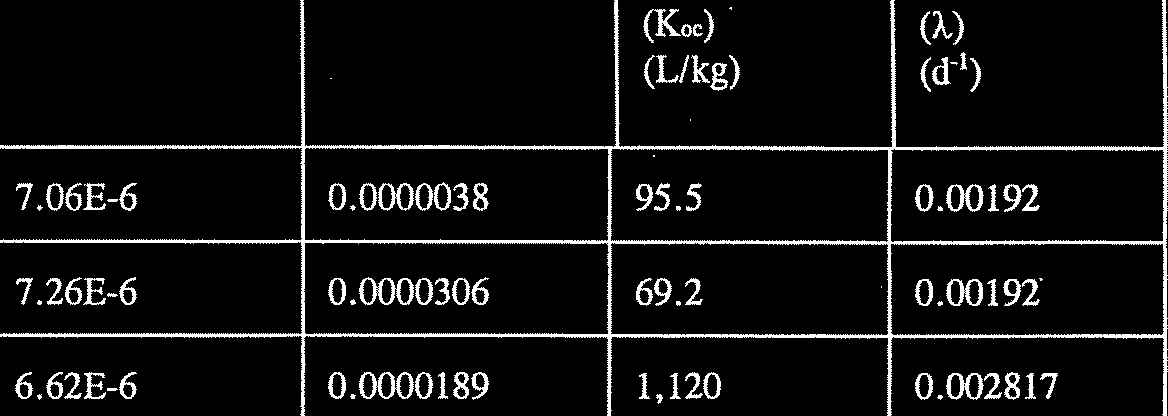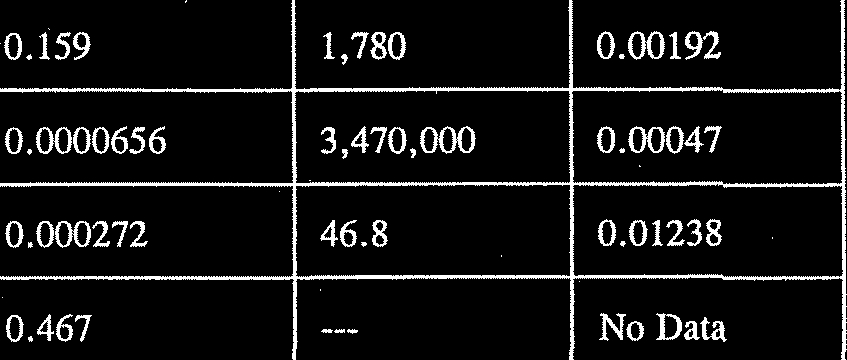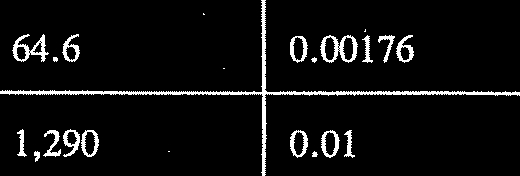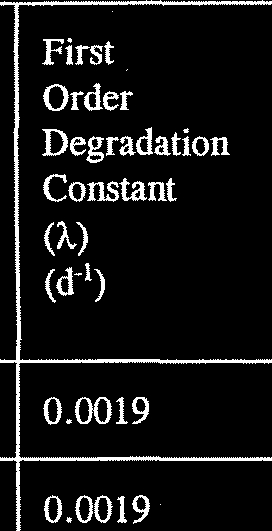.
ILLINOIS POLLUTION CONTROL BOARD
September
6,
2001
IN THE MATTER OF:
)
)
PROPOSED AMENDMENTS TO
TIEED
)
ROO-l9(C)
APPROACH TO CORRECTIVE ACTION
)
(Rulemaking
-
Land)
OBJECTIVES (TACO) (MTBE): 35 ILL.
)
ADM.
CODE 742
)
Proposed Rule. First Notice.
OPINION AND ORDER OF THE BOARD (by
E.Z. Kezelis, N.J. Melas, R.C.
Flemal):
On May 15, 2000, the Illinois Environmental Protection Agency (Agency) filed a
proposal to amend 35 111.
Adm.
Code 742
of
the Board’s land regulations, commonly referred
to as the Tiered Approach to Corrective Action Objectives (TACO) rules.
The Board accepted
this matter for hearing on May 18,2000. On July 27,2000, the Board moved the Agency’s
proposed rulemaking to first notice. In doing so, the Board divided the proposal into two
subdsckets, A and
B.‘ This Subdocket C was opened by the Board on June 7,
2001; for the
purpose of addressing the proposed cleanup standards for methyl tertiary-butyl
eth-er (MTBE)
that were originally contained in Subdocket B. It is these proposed MTBE cleanup standards,
that
the Board
is
adopting today for first notice.
.
The cleanup standards for MTBE were originally proposed at first notice as part of the
Board’s first-notice opinion and order in
R00-19(B). See Proposed Amendments to,
Tiered
Approach
to Corrective Action Objectives (TACO): 35
Ill. Adm. Code 742,
R00-19(B) (July 27,
2000). By creating a separate Subdocket
C
for the MTBE amendments, the Board intends to
.
coordinate this rulemaking with another pending Agency proposal that would add groundwater
quality
standaxds for MTBE.
See
generaZZy
Proposed MTBE Groundwater
Quality Standards
Amendments: 35
Ill.
Adm. Code 620,
R01-14.
By today’s action, and pursuant to the Administrative Procedures Act
(5
ILCS
100/1-1
et
seq.
(2000)),
the Board proposes new cleanup standards for MTBE. The proposed amendments
will be published in the
Illinois Register,
whereupon a 45-day public comment period will begin.
During the public comment period, any interested persons may file public comments with the
Board pertaining to this proposal.
PROCEDURAL HISTORY
The Subdocket A amendments were adopted on December 21, 2000 (Proposed Amendments
to Tiered Approach to Corrective Action
0b.jectives (TACO): 35
Ill. Adm. Code 742,
ROO-
19(A)), and the Subdocket B amendments were adopted on July 26, 2001 (Proposed
Amendments to Tiered Approach to Corrective Action Objectives (TACO): 35
111.
Adm. Code
742,
ROO-l9(B)).
2
PROCEDURAL
HISTORY
While
public hearings have not yet been held in this Subdocket specifically, three public
hearings were held in Subdockets A and B. At the time of the public hearings, the proposed
MTBE cleanup standards were part of Subdocket
€3.
The first and third hearings were held in
Chicago on August 25,2000 and September 21,2000. The second hearing was held in
Springfield on September
1
1,2000.
At the August 25,2000 hearing, the Agency presented testimony from a number of
witnesses. Douglas Clay, Manager of the Leaking Underground Storage Tank Section of the
Agency’s Bureau of Land, Thomas Hornshaw, Senior Public Service Administrator and Manager
of the Toxicity Assessment Unit, Office of Chemical Safety, and Richard Cobb, Manager of the
Groundwater Section of the Agency’s Bureau of Water, testified regarding the proposed
addition of MTBE cleanup standards. During the September
11
,
2000 hearing, Mr. Clay and Mr.
Cobb both testified regarding the proposed MTBE standards on behalf of the Agency, and David
Sykuta testified on behalf of the Illinois Petroleum Council. The Agency also submitted the
following two exhibits at hearing:
Exhibit No.
Exhibit Name
Agency Exh. 1
Group exhibit consisting of prefiled
Testimony of Agency witnesses
Agency Exh. 2
“Basis for Proposing a Preventive
Notice and Response Level for MTBE
In 35
Ill.
Adm.
Code
620”2
The Board hereby incorporates by reference those exhibits, transcripts, and public
comments
from Subdockets A and B into this Subdocket C proceeding.
PROPOSED MTBE STANDARDS
The Agency stated that it was proposing to add cleanup standards for MTBE as a result
of increasing national concern over the growing number of community water supplies that test
positive for MTBE contamination. Stat. of Reas. at
2-3.
In his testimony, Mr. Clay reiterated
that the “proposal arose as a result of increased national health
concerns.’y Agency Exh. 1
(Clay) at 1.
The proposed cleanup standards and chemical and physical parameters for MTBE are
found in the appendices to Part 742 as follows: Appendix A, Table A (soil saturation limits);
Appendix A, Table E (similar-acting noncarcinogenic chemicals); Appendix B, Table A (soil
remediation objectives for residential properties); Appendix B, Table B (soil remediation
For purposes of this opinion and order, references to “Agency Exh. 1” will specify the name
of the witness providing the quoted testimony, such as, “Agency Exh. 1 (Clay) at
-
.”
The
Agency’s Statement of Reasons is referred to as “Stat. of Reas. at
-
.”
3
objectives for
industrial/commercial properties); Appendix B, Table E (groundwater
remediation objective for groundwater component of groundwater ingestion route); Appendix
B, Table F (values used to calculate the Tier 1 soil remediation objective for the soil
component of groundwater ingestion route); and Appendix C, Table E (default physical and
chemical parameters).
As
background information, Mr. Clay testified as follows:
MTBE is a volatile, organic chemical. Since the late
1970’s, MTBE has been
used as an octane enhancer in
gasoline. Because it promotes more complete
burning of gasoline, thereby reducing carbon monoxide and ozone levels, it is
commonly used as a gasoline additive in localities with air quality concerns. In
the Clean Air Act of 1990
(“CAA”), Congress mandated the use of
reformulated gasoline
(“RFG”) in areas of the country with the worst ozone or
smog problems. RFG must meet certain technical specifications set forth in the
CAA, including a specific oxygen content. Ethanol and MTBE are the primary
oxygenates used to meet the oxygen content requirement. MTBE is used in
about 84
%
of RFG supplies. Prior to December 1997, 32 areas in a total of 18
states were participating in the RFG program. During this same period, RFG
accounted for about 30% of gasoline nationwide. Agency Exh. 1 (Clay) at 2-3.
Mr. Clay also testified that MTBE is now being detected in increasing quantities in the
environment. Agency Exh. 1 (Clay) at 3. Mr. Clay testified that, as of August 2000, 26 of
1,200
cornunity water supplies in Illinois tested positive for MTBE contamination.
Id.
Four
of the 26
community water supplies had to discontinue use of groundwater wells as a result of
the MTBE contamination.
Id.;
Tr.
(8/25/00) at 79. He testified that MTBE is ”a big
issue
. . .
[and has] been a big issue for a number of years.” Tr.
(8/25/00) at 117.
According to Mr. Clay, MTBE contamination is problematic because MTBE disperses
rapidly and degrades slowly. Agency Exh. 1 (Clay) at 4. Furthermore, once in groundwater,
MTBE is difficult to clean up. Tr.
(8/25/00) at 119.
While most of the MTBE-contaminated drinking water in Illinois is not thought to pose
a threat to human health, Mr. Clay noted that the United States Environmental Protection
Agency
(USEPA) is continuing to evaluate the potential risks to human health from MTBE.
Tr.
(8/25/00) at 119. Mr. Clay explained that,
“[olne of the main concerns is determining
what is the
cancer-causing potential of MTBE,” noting that there is evidence “that MTBE
caused cancer in laboratory rats.
”
Id.
In addition to the potential risk to human health, Mr. Clay also testified that consumers
of drinking water are able to detect MTBE through taste and smell at concentrations of as little
as 20 to 40 parts per billion
@pb), Agency Exh. 1 (Clay) at 4. Mr. Clay commented that
MTBE is described as tasting and smelling like turpentine.
Id.
However, since MTBE has not
4
previously been a contaminant for which sampling is required, there is little data on the actual
presence or extent of MTBE contamination in Illinois.
Id.
In support of the proposed MTBE cleanup standards, Mr. Clay testified about a “Blue
Ribbon Panel” (panel) appointed by former United States
Environmental Protection Agency
(USEPA) Administrator Carol Browner. Specifically, Mr. Clay noted that the panel concluded
that “MTBE is more likely to contaminate groundwater and surface water than the other
components of gasoline [and]
[olnce MTBE is in groundwater, its physical and chemical
properties make it very difficult to remediate.” Agency Exh. 1 (Clay) at 5, citing generally
Clay Exh.
27.3
Dr
.
Hornshaw provided testimony regarding the “toxicological bases for the proposed
remediation objectives.” Agency Exh. 1 (Hornshaw) at 2. In support of the proposed
standards, Dr. Hornshaw noted the “increased incidence of diarrhea and increased level of
cholesterol in the blood of laboratory rats for the soil and groundwater ingestion pathways and
liver and kidney effects for the inhalation pathway.
”
Id.
Dr
.
Hornshaw stated that in response to detection of MTBE in a community water
supply, the Agency developed a “toxicity criterion value for the ingestion pathways for
noncarcinogens [reference dose]
. . .
for use in
. . .
a proposed Health Advisory for
MtBE
[sic].” Agency Exh. 1 (Hornshaw) at 2.
Dr. Hornshaw explained, however, that the Agency
did not address the potential carcinogenic effects of MTBE in the Health Advisory. Tr.
(8/25/00)
at 122. He testified that when the Health Advisory was originally drafted in 1993,
the information was not sufficient for USEPA or, accordingly, the Agency, to
make a
determination as to whether MTBE poses a cancer risk for humans.
Id.
at 122-23. Since
1993, however, USEPA has been reviewing new information that “suggests that maybe cancer
is [a] relevant [end] point for humans based on
anirnal data, but that decision has not been
made at the federal level, and [the Agency is] not prepared to make that decision as an agency
right now.”
Id.
at 123. As a result, the Agency relied on a “noncancer end
point” in
making
its proposals to the Board for MTBE cleanup standards.
Id.
The numbers proposed by the Agency are based on an action level of 20 ppb, a
groundwater standard of 70 ppb, and inclusion of MTBE as an indicator contaminant for
gasoline. Agency Exh. 1 (Clay) at 5. According to Mr. Clay, the 20 ppb is based on taste and
odor threshold, while the 70 ppb is a health-based number.
Id.
Dr. Hornshaw further states
that the reference dose for calculating the cleanup objectives was taken from
USEPA’s
Integrated Risk Information System (IRIS)
and that the
physicalfchemical parameters were
taken from USEPA databases known as “CHEMFATE” and
“CHEMDAT8.” Tr.
(8/25/00) at
123.
Wile the Agency has provided the Board with information supporting the proposed
standards, the record is lacking a detailed explanation of the calculations employed by the
Exhibits attached to Mr. Clay’s
premed testimony are referred to as “Clay Exh.
IRIS
is
USEPA’s computer-based
sumary of the health risks, appropriate
dailyexposures,
.”
and evaluations of cancer risks for over 600 chemicals. Tr.
(8/25/00)
at 157.
5
Agency in reaching the proposed numbers. The Board specifically requests supplementation
in
this
regard from the Agency during this first-notice period.
Dr. Hornshaw testified that he is aware of other states (California and New York)
where the potential carcinogenicity of MTBE has prompted adoption of standards that are less
than those proposed for Illinois. Tr.
(8/25/00) at 123-24.
On behalf of the Illinois Petroleum Council (Petroleum Council), Mr.
Sykuta testified
that he agrees that MTBE is a problem and that the Petroleum Council is working closely with
the Agency to develop a protocol for dealing with it. Tr.
(9/11/00) at 11
1. The Petroleum
Council supports the 70 ppb cleanup standard for MTBE.
Id.
at 112. The Petroleum Council,
however, is concerned that the 20 ppb action level will somehow become the cleanup standard
and they are not prepared for that.
Id.
at 113.
He urged the Board to consider a couple of factors when proposing an MTBE standard,
First, he asked the Board to remember the importance of keeping the leaking underground
storage tank (LUST) program
fmancially viable. Tr.
(9/11/00) at 114. Second, he reminded
the Board that the inclusion of MTBE in gasoline was required by law and to “penalize people
for obeying the law as it existed at that
time,” would be unfair.
Id.
Mr. Cobb testified in response to the Petroleum Council’s testimony. Specifically, he
addressed the preventative response or
“action” level of 20 ppb. Mr. Cobb testified that there
are four reasons why the 20 ppb preventative response level is appropriate: (1) it meets the
taste and odor threshold set by
USEPA for MTBE; (2) a preventative response level is required
by Section 8 of the Illinois Groundwater Protection Act (415 ILCS
5518
(2000)); (3) there is
existing regulatory authority and precedent in the Board’s existing groundwater quality
standards; and
(4)
there is no history of applying the preventative response level to LUST
projects as a cleanup objective. Tr.
(9/11/00) at 123.
Regarding the proposed default physical and chemical parameters for MTBE found in
35
Ill.
Adm. Code
742.Appendix C, Table E, Dr. Hornshaw testified that the proposed value
for the MTBE first-order degradation constant
(A)
of
0.00193/day was derived from a
“preferred” source (Philip H. Howard, Handbook of
Environmental Fate and Exposure Data
for Organic Chemicals, (Lewis Pub. 1989)). The Agency, however, suggested that the Board
consider setting the
h
value at
O/day. The Agency stated that it was uneasy about the proposed
value since reports from sites in Illinois and other sites across the nation indicate MTBE is
very difficult to remove using biological degradation treatment technologies.
Exh. 1
(Hornshaw) at 3. In this regard, the Petroleum Council noted that there is insufficient data at
present to propose a degradation constant for MTBE that could be universally applied to all
groundwater models. The Petroleum Council supports a default MTBE degradation rate of
“O/day.
”
The Petroleum Council also requested language in the rule to allow the use of a site
specific degradation constant where appropriate. PC 4, ROO-1
9B.
6
As suggested by the Agency, the Board considered what the most appropriate value
would be for an MTBE first-order degradation constant and reviewed Volume 4 of the
Agency’s preferred reference Handbook of Environmental Fate and Exposure Data for Organic
Chemicals by P.H. Howard. The 1993 printing states, “No data concerning the
biodegradation of MTBE in environmental media were located.
”
In addition, the Board also
reviewed the studies identified by the Petroleum Council regarding an MTBE first-order
degradation
constant.* Our review,
in combination with the Agency’s and the Petroleum
Council’s comments, indicates that there is insufficient data to assign a first-order degradation
constant to MTBE on a State-wide basis.
The Board will revise the First Order Degradation Constant for MTBE as “No Data” in
Part
742.Appendix C, Table E. By doing so, the rules at Part
742.Appendix C, Table C will
allow the use of a default value of
Olday.
In addition, Section
742.810(a)(l) allows the use of
first order degradation rate determined by using site-specific data. This approach is intended
to address both the Agency’s and the Petroleum Council’s concerns.
MTBE GROUNDWATER QUALITY STANDARD
As noted previously, the Board deliberately established this Subdocket C so as to
coordinate the proposal and adoption of groundwater quality standards for MTBE.
Specifically, the Board has today proposed for
first notice a groundwater quality standard of 70
-
-
ppb.
See
Proposed MTBE Groundwater Quality Standards Amendments: -35
Iil.
Adrn. Code
-
620,
RO1-14 (Sept. 6, 2001). Because of the closely related nature of the evidence submitted
in the groundwater proceeding, the Board hereby incorporates the hearing transcripts and
evidence from
RO1-14 into this proceeding.
DISCUSSION
The Board has concluded that the MTBE TACO standards should be consistent with the
groundwater quality standards. Accordingly, the Board adopts for first notice the TACO
standards for MTBE as originally proposed by the Agency in March 2000. These standards
are based on a non-carcinogenic endpoint for MTBE.
In considering the information submitted in the course of ROl-14, the Board examined a
study performed by the California Environmental Protection Agency entitled, “Public Health
Goals for Methyl-Tertiary Butyl Ether (MTBE) in Drinking
Water” (PHG Report).
See
Exh.
13
(RO1-14).
The PHG Report concluded that there is evidence of the carcinogenicity of
MTBE.
Based on the PHG Report, the California Department of Public Health adopted a
drinking water standard of 13 ppb for MTBE.
See
Proposed MTBE Groundwater Quality
Standards Amendments: 35
Ill. Adm. Code 620,
RO1-14 (Sept. 6,
2001), for additional
discussion of the PHG Report.
See PC 4 for a list of the studies identified by the Petroleum Council.
7
While the Board recognizes that there is evidence suggesting the possible
carcinogenicity of MTBE, the Board, in adopting standards for 35
Ill. Adm. Code
742,
cannot
consider MTBE to be a
carcinogen unless the contaminant meets the definition of a
“carcinogen” found at Section 58.2 of the Act
(415
ILCS
5158.2 (2000)) and again at 35
Ill.
Adm. Code 742.200.
Section 58.2 of the Act defines
“carcinogeny’
as follows:
“Carcinogen” means a con
taminant that is classified as a Category
A1 or A2
Carcinogen by the American Conference of Governmental Industrial Hygienists;
or a Category 1 or
2A/2B Carcinogen by the World Health Organizations
International Agency for Research on Cancer; or a
“Human
Carcinogen” or
“Anticipated Human
Carcinogen” by the United States Department of Health
and Human Service National Toxicological Program; or a Category A or
BUB2
Carcinogen by the United States Environmental Protection Agency in Integrated
Risk
Information System or a Final Rule issued in a Federal Register notice by
the
USEPA as of the effective date of this amendatory Act of
1995. 415
ILCS
5/58.2
(2000).
Because, as of this date, none of the entities specified above have declared MTBE to be
a human carcinogen pursuant to Section 58.2 of the Act, the Board concludes that it is legally
unable to use a carcinogenic based endpoint for calculating the TACO cleanup standards for
this first notice and will, instead, proceed to first notice with the remediation objectives
proposed by the Agency. The Board invites public comment on this conclusion and the
Board’s interpretation of the
constraining effect of Section 58.2 of the Act.
The Board notes that each of the agencies referenced in Section 58.2 of the Act is
currently examining the issue of MTBE and whether it should be classified as a carcinogen.
The Board will be monitoring the progress of these agencies closely, as will, of course, the
Agency, and will consider amendments to the TACO rules to reflect any future adjustments in
the classification of MTBE.
Finally, although the Board does not declare that MTBE is
a
carcinogen, the Board
nevertheless concludes that the TACO cleanup standards proposed herein are scientifically
sound and are protective of human health and the environment. The Board encourages public
comment in this regard and plans to schedule public hearings in the near future for the purpose
of receiving additional comment and testimony regarding the proposed standards,
ORDER
The Board directs the Clerk to cause the filing of the following with the Secretary of
State for first-notice publication in the
IZZinois
Register.
8
Section
742.100
742.105
742.1 10
742.115
742.120
Section
742.200
742.205
742.210
742.215
742.220
742.225
742.230
Section
742.300
742.305
742.3 10
742.3 15
742.320
Section
742.400
742.405
742.41 0
742.415
TITLE 35: ENVIRONMENTAL PROTECTION
SUBTITLE G: WASTE DISPOSAL
CHAPTER I: POLLUTION CONTROL BOARD
PART
742
TIERED APPROACH TO CORRECTIVE ACTION OBJECTIVES
SUBCHAPTER f
RISK BASED CLEANUP OBJECTIVES
SUBPART A: INTRODUCTION
Intent and Purpose
Applicability
Overview of Tiered Approach
Key Elements
Site Characterization
SUBPARTB: GENERAL
Definitions
S
everability
Incorporations by Reference
Determination of Soil Attenuation Capacity
Determination of Soil Saturation Limit
Demonstration of Compliance with
Remediation Objectives
Agency Review and Approval
SUBPART C: EXPOSURE ROUTE EVALUATIONS
Exclusion of Exposure Route
Contaminant Source and Free Product Determination
Inhalation Exposure Route
Soil Ingestion Exposure Route
Groundwater Ingestion Exposure Route
SUBPART D: DETERMINING
m
A
BACKGROUND
Area Background
Determination of Area Background for Soil
Determination of Area Background for Groundwater
Use of Area Background Concentrations
SUBPART E: TIER 1 EVALUATION
9
Section
742.500
742.505
742.5 10
Section
742.600
742.605
742.610
Section
742.700
742.705
742.710
742.715
742.720
Section
742.800
742.805
742.810
Section
742.900
742.905
742.910
742.915
742.920
742.925
742.93
0
Section
742.1000
742.1005
742.1 0 1
0
742.10 12
Tier 1 Evaluation Overview
Tier 1 Soil and Groundwater Remediation Objectives
Tier 1 Remediation Objectives Tables
SUBPART F: TIER 2
GENEW EVALUATION
Tier 2 Evaluation Overview
Land Use
Chemical and Site Properties
SUBPART G: TIER 2 SOIL EVALUATION
Tier 2 Soil Evaluation Overview
Parameters for Soil Remediation Objective Equations
SSL Soil Equations
RBCA Soil Equations
Chemicals with Cumulative Noncarcinogenic Effects
SUBPART H: TIER 2 GROUNDWATER EVALUATION
Tier 2 Groundwater Evaluation Overview
Tier 2 Groundwater Remediation Objectives
Calculations to Predict Impacts
ftom Remaining Groundwater Contamination
SUBPART I: TIER 3 EVALUATION
Tier 3 Evaluation Overview
Modifications of Parameters
Alternative Models
Formal Risk Assessments
Impractical Remediation
Exposure Routes
Derivation of Toxicological Data
SUBPART J: INSTITUTIONAL CONTROLS
Institutional Controls
No Further Remediation Letters
Environmental Land Use Controls
Federally Owned Property: Land Use Control Memorandums of Agreement
10
742.1015
Ordinances
742.1020
Highway Authority Agreements
SUBPART K: ENGINEERED BARRIERS
Section
742.1 100 Engineered Barriers
742.1 105 Engineered Barrier Requirements
APPENDIX A
General
ILLUSTRATION A Developing Soil Remediation Objectives Under the Tiered Approach
ILLUSTRATION B Developing Groundwater Remediation Objectives Under the Tiered
Approach
TABLE A
Soil Saturation
Limits
(C,,)
for Chemicals Whose Melting Point is Less than
30°C
TABLE B
Tolerance Factor (K)
TABLE C Coefficients
(AN-I+I
1 for
W Test of Normality, for
N=2(
l)50
TABLE D Percentage Points of the
W Test for
n=3(1)50
TABLE E
Similar-Acting Noncarcinogenic Chemicals
TABLE F
Similar-Acting Carcinogenic Chemicals
TABLE G
TABLE
H
Concentrations of Inorganic Chemicals in Background Soils
Chemicals Whose Tier 1 Class I Groundwater Remediation Objective Exceeds
the 1 in 1,000,000 Cancer Risk Concentration
APPENDIX B
Tier 1 Tables and Illustrations
ILLUSTRATION A
Tier 1 Evaluation
TABLE A Tier 1 Soil Remediation Objectives for Residential Properties
TABLE B
Tier 1 Soil Remediation Objectives for
IndustriallCornrnerciaI
Properties
TABLE C
pH Specific Soil Remediation Objectives for Inorganics and Ionizing Organics
for the Soil Component of the Groundwater Ingestion Route (Class I
Groundwater)
pH Specific Soil Remediation Objectives for Inorganics and Ionizing Organics
for the Soil Component of the Groundwater Ingestion Route (Class 11
Groundwater)
Tier 1 Groundwater Remediation Objectives for the Groundwater Component of
the Groundwater Ingestion Route
Values Used to Calculate the Tier 1 Soil Remediation Objectives for the Soil
Component of the Groundwater Ingestion Route
TABLE D
TABLE E
TABLE F
APPENDIX C Tier 2 Tables and Illustrations
ILLUSTRATION A
Tier 2 Evaluation for Soil
ILLUSTRATION B
Tier 2 Evaluation for Groundwater
ILLUSTRATION C
US Department of Agriculture Soil Texture Classification
TABLE A
SSL Equations
TABLE B
SSL
Parmeters
TABLE C
RBCA Equations
11
Chemical Name
Acetone
TABLE D
TABLE E
TABLE F
TABLE G
TABLE H
TABLE I
TABLE J
TABLE
IS
AUTHORITY:
Cssr
(mglkg)
100,000
RBCA Parameters
Default Physical and
Chemical Parameters
Methods for Determining Physical Soil
Pasmeters
Error Function
(erf)
Q/C Values By Source Area
GC
Values for Ionizing Organics as a Function of
pH
(cm3/g or
L/kg or
Values to be Substituted for
of
pH
(cm3/g or
Lkg or
~m~~~t~/g~~il)
Parameter Estimates for
Calculating Water-Filled Soil Porosity
(Ow)
3
cm
water/gsoid
or
k,-when Evaluating
Inorganics as a Function
Benzene
Bis(2-chloroethy1)ether
Bis(2-ethylhexy1)phthalate
Bromodichloromethane
(Dichlorobromomethane)
Implementing Sections
22.4,22.12, Title
XVI, and Title XVII and authorized by
870
3,300
3 1,000
3.000
Sections 27 and 58.5 of the Environmental Protection Act
[415 ILCS
5/22.4,22.12,27, and 58.5
and Title XVI and Title
XVLI].
Butanol
Butyl benzyl phthalate
Carbon disulfide
Carbon tetrachloride
Chlorobenzene
(Monochlorobenzene)
SOURCE: Adopted in
R97-12(A) at 21
Ill. Reg. 7942, effective July
1, 1997; amended in
R97-
12(B) at 21
Ill. Reg. 16391, effective December 8, 1997; amended
in
R97-12(C)
at 22
Ill. Reg.
10847, effective June 8,1998; amended in
R00-19(A) at 25 111. Reg. 651, effective January
6,
2001; amended in
R00-19(B) at 25
Ill. Reg. 10374, effective August 15,2001; amended in
R00-19(C) at 25
Ill. Reg.
NOTE: Capitalization
indicates statutory language.
,
effective
10,000
930
720
1,100
680
Section
742.APPENDIX
A:
General
Chloroform
Section
742.TABLE
A:
Soil Saturation Limits
(&)for
Chemicals Whose Melting Point is Less
than
30"
C
2,900
I
67-64- 1
171-43-2
175-25-2
171-36-3
85-68-7
75-15-0
56-23-5
108-90-7
Bromoform
I
1,900
I
Chlorodibromomethane
(Dibromochloromethane)
I
1.300
1
12
96-12-8
1,2-Dibromo-3-chloropropane
1,400
I--
~
I
I
84-74-2
95-50- 1
Di-n-butyl phthalate
2,300
1,2-Dichlorobenzene
(o-Dichlorobenzene)
560
75-34-3
107-06-2
75-35-4
1,
I-Dichloroethane
1,700
1
,2-Dichloroethane (Ethylene dichloride)
1,800
1.1-Dichloroethvlene
1,500
____
156-59-2
156-60-5
78-87-5
cis-1
,2-Dichloroethylene
1,200
trm-l,2-Dichloroethylene
3,100
1,2-Dichloropropane
1,100
542-75-6
84-66-2
117-84-0
1759-2
I
Methylene chloride
(Dichloromethane)
1,3-Dichloropropene
(1,3-Dichloropropylene,
cis
-+
tram)
1,400
Diethyl phthalate
2,000
Di-n-octyl phthalate
10,000
2,400
100-41-4
77-47-4
78-59-1
74-83-9
Ethylbenzene
400
Hexachloroc
y ciopentadiene
2,200
Isophorone
4,600
Methyl bromide
(Bromomethane)
3,200
98-95-3
Nitrobenzene 1,000
rl20-82-1
I
1,2,4-Trich~orobenzene
100-42-5
127-1
8-4
3,200
Styrene
1,500
Tetrachloroethylene (Perchloroethylene) 240
108-88-3
Toluene
650
I
420
71-55-6
79-00-5
1
,
1
,
1-Trichloroethane
1,200
1,l
,2-Trichloroethane
1,800
-
79-0 1-6
108-05-4
75-01-4
Trichloroethylene
1,300
Vinyl acetate 2,700
Vinyl chloride 1,200
13
95-47-6
0-Xylene
106-42-3
p-Xylene
410
460
1330-20-7
95-57-8
(Source: Amended at 25
Ill. Reg.
,
effective
)
Xylenes (total)
320
Ionizable Organics
2-Chlorophenol
53,000
14
Section
742.APPENDIX A: General
Section 742. TABLE E: Similar-Acting Noncarcinogenic Chemicals
15
16
Adrenal Gland
Nitrobenzene
1,2,4-Trichlorobenzene (Ingestion only)
Kidnev
Acetone (Ingestion only)
Cadmium (Ingestion only)
Chlorobenzene
Dalapon
1,l-Dichloroethane
Di-n-octyl phthalate (Ingestion only)
Endo sulfan
Ethylbenzene
Fluor anthene
Methyl tert-butyl ether (Inhalation only)
Nitrobenzene
Pyrene
Toluene (Ingestion only)
2,4,5-Trichlorophenol
Vinyl acetate (Inpestion only)
Liver
Acenaphthene
Acetone (Ingestion only)
Butylbenzyl phthalate (Ingestion only)
Chlorobenzene (Ingestion only)
1,l-Dichloroethylene (Ingestion only)
Di-n-octyl phthalate (Ingestion only)
Endrin
Ethylbenzene
Fluoranthene
Methyl tert-butyl ether (Inhalation only)
'
Nitrobenzene
Picloram
Styrene (Ingestion only)
2,4,5-TP (Silvex)
Toluene (Ingestion only)
1,2,4-Trichlorobenzene (Inhalation only)
2,4,5
-Trichlorophenol
Central Nervous System
Butanol (Ingestion only)
Cyanide (amenable)
2,4-Demethylphenol
Endrin
Manganese
2
,Methylphenol
Mercury (Inhalation only)
Styrene (Inhalation only)
Toluene (Inhalation only)
Xylenes (Ingestion only)
Circulatorv System
Antimony
Barium. (Ingestion only)
cis-
1,2-Dichloroethylene (Ingestion only)
Nitrobenzene
trans-1,2-Dichloroethylene
(Ingestion only)
2
,LC-Dimethylphenol
Fluoranthene
Fluor ene
Styrene (Ingestion only)
Zinc
Gastrointestinal System
Beryllium (Ingestion only)
Endothall
Hexachlorocyclopentadiene (Ingestion only)
Methyl bromide (Ingestion only)
Methyl tert-butyl ether (Ingestion only)
2,4-D
17
Immune System
2,4-Dichlorophenol
p-Chloroaniline
Mercury (Ingestion only)
Reproductive System
Barium (Inhalation only)
Boron (Ingestion only)
Carbon
disulfide
2-Chlorophenol (Ingestion only)
172
Dibromo-3-Chloropropane (Inhalation only)
Dinoseb
Ethylbenzene (Inhalation only)
Methoxychlor
Phenol
ResDiratory System
1
,ZDichloropropane (Inhalation only)
173-Dichloropropylene
(Inhalation only)
Hexachlorocyclopentadiene (Inahalation only)
Methyl bromide (Inhalation only)
Naphthalene (Inhalation only)
Toluene (Inhalation only)
Vinyl acetate (Inhalation only)
Cholinesterase Inhibition
Aldicarb
Carbofuran
Decreased Bodv Weight Gains
and
Circulatorv System Effects
Atrazine
Simazine
(Source: Amended at 25
Ill. Reg.
-7
effective
1
Section
742.APPENDIX B: Tier 1 Tables and Illustrations
CAS No.
Chemical Name
83-32-9
Acenap hthene
67-64-1
Acetone
15972-60-8
Alachlor"
116-06-3
Aldicarb"
309-00-2
Aldrin
120-12-7
Anthracene
1912-24-9
Atrazine"
71-43-2
Benzene
5
6
-
5
5
-
3
205-99-2
Benzo(b)fluoranthene
Benzo(u)anthracene
'
Section
742.TABLE
A:
Tier 1 Soil Remediation Objectives
a for Residential Properties
Exposure Route-Specific Values for Soils
Soil Component of the Groundwater
Ingestion Exposure Route
Values
Ingestion Inhalation Class
I
Class
I1
ADL
tmg/kg)
(mgW
(mg/kg)
tmgfkg)
tmgw
4,700b
---
7,800b
100,000d
1
Sb
16
*
C
*
570b
2,900
C
w
03
8"
---
0.04
0.2
NA
78b
---
0.013
0.07
NA
0.04"
3e
0.5"
2.5
0.94
C
C
*
23,0wb
-_-
12,000b
59,000
C
27Wb
---
0.066
0.33
NA
12"
0.8"
0.03
0.17
*
0.Y
---
2 8
*
0.9"
---
5
25
*
C
c
Ingestion
Inhalation
(mgW
(mg/kg)
C
9"
---
0.09"-f
---
C
0.6'
0.2e.f
46"
3 1
,OOOd
1
oe
3
,mod
81"
53e
7,8OOb
10,000d
16,
OOOb
930d
32e
_--
390b
---
7,800b
720d
C
C
I
I
Class I
Class
II
ADL
(mg/kg)
(mg/kg)
(mi&)
49 250
8 82
*
*
0.
0004e7f
0.0004
0.66
3,600
3 1
,OOOd
*
0.6
0.6
*
0.8
0.8
*
17b
17
NA
930d
930d
*
O
he
2.8
NA
0.22
1.1
NA
32b
160
*
Exposure Route-Specific Values for Soils
CAS No.
207-08-9
50-32-8
11
1-44-4
117-8 1-7
75-27-4
75-25-2
71-36-3
85-68-7
86-74-8
1563-66-2
75-15-0
Soil Component of the Groundwater
Ingestion Exposure
Route
Values
Chemical Name
Benzo(k) fluroanthene
Benzo(u)pyrene
Bis(2-chloroethy1)ether
Bis(2-ethylhexyl)ph~alat~
Bromodichloromethane
(Dichlorobromomethane)
Bromoform
Butanol
Butyl benzyl phthalate
Carbazole
Carbofuran"
Carbon
disulfide
CAS No.
56-23-5
57-74-9
106-47-8
108-90-7
I
(Monochlorobenzene)
1
Chemical Name
Carbon tetrachloride
Chlordane
4-Chtoroaniline
@-Chloroaniline)
Chlorobenzene
124-48-
1
67-66-3
21 8-0 1-9
94-75-7
75-99-0
72-54-8
72-55-9
Exposure Route-Specific Values for Soils
Chlorodibromomethane
~Dibromochiorome~ane)
Chloroform
Chrysene
2,4-D?
Dalapon"
DDD
DDE
Soil Component of the Groundwater
Ingestion Exposure Route
Values
C
*
310b
---
0.7b
0.7
1
6.5
I
I
130b
I
1
,6Wb
I
*
1
,600b
1,30Od
0.4
0.4
*
100"
0.3"
0.6
2.9
*
88"
---
160 800
*
780b
---
1.5 7.7
*
2,300b
--_
0.85
8.5
C
C
C
*
C
3"
---
16"
80
2"
---
54"
270
*
C
*
N
0
Chemical Name
I
50-29-3
53-70-3
96-12-8
106-93-4
84-74-2
DDT
Dibenzo(a,
h)anthracene
1,2-Dibrom0-3-chloropropane
1,2-Dibromoethane
(Ethylene dibromide)
Di-n-butyl phthalate
7.800b
7,
OoOb
I
0,
-
Dichlorobenzene)
I!
2,300d
2,300d
2,3OOd
*
560d
17
43
*
91-94- 1
3,3
'-Dichlorobenzidine
75-34-3
1,l-Dichloroethane
95-50-1
106-46-7
Exposure Route-Specific Values
for
Soils
1,2-Dichlorobenzene
(0
-
Dichlorobenzene)
1,4-Dichlorobenzene
Soil
Component of the Groundwater
Ingestion Exposure Route
Values
_--
c
0.0075"
ll,mb
2
11
*
0.17"
1"
7,80Ob
0.0004
---
C
0.007""
0.033
1.3
1
,300b
23b
110
*
O-Oo4
I
O*Oo5
CAS
No.
107-06-2
75-35-4
156-59-2
156-60-5
78-87-5
542-75-6
60-57- 1
84-66-2
105-67-9
121
-
14-2
Exposure Route-Specific Values for Soils
Chemical Name
1,2-Dichloroethane
(Ethylene dichloride)
1,l
-Dichloroethylene
cis-
1,2-DicNoroethylene
trans-
1,2-DicNoroethylene
1,2-Dichloropropane
1,3-Dichloropropene
(1,3-DichloropropyIene,
cis
-t
trans)
Dieldrin"
Diethyl phthalate
2,4-Dimethyiphenol
2,4-Dinitrotoluene
Soil
Component
of the Groundwater
Ingestion Exposure Route
Values
7"
0.4"
700b
1
,5OOd
0.06
0.3
*
780b
1,200d
0.4
1.1
*
1
,6Wb
3,l0Od
0.7
3.4
*
9"
Hb
0.03
0.15
*
6.4"
l.le
0.004e
0.02
0.005
0.04e
le
0.004"
0.02
0.603
63,000b
2,000d
470b
470
*
1
,6Wb
---
9b
9
C
*
3
C
0.ge
-_-
0.0008e*f
0.0008
0.250
N
N
CAS
No.
Chemical Name
606-20-2
2,6-Dinitrotoluene
145-73-3
Endothall"
72-20-8
Endrin
100-11-4
Ethyl benzene
206-44-0
Fluoranthene
86-73-7
Fluorene
76-44-8
Heptachlor
1024-57-3
Heptachlor epoxide
3 19-84-6
Alpha-HCH (alpha-BHC)
Exposure Route-Specific Values for Soils
Soil
Component of the Groundwater
Ingestion Exposure Route
Values
Ingestion Inhalation Class
I
Class
II
ADL
(mg/kg)
(mg/kg)
@&kg)
(wdkg)
(mglkg)
0.9'
---
0.
0007e7f
0.0007
0.260
1
,60Ob
l0,ooOd
10,oood
10,000d
*
470b
---
1
gb
90
*
1
,6Wb
---
0.4
0.4
NA
C
C
C
7,80Ob
400d
13
19
*
3,100b
---
C
4,300b
21,000
*
c
*
3,lOOb
---
560b
2,800
0.1'
0.1"
23
110
0.871
0.4"
1"
2
11
*
0.1=
0.8"
0.0005"*f
0.003
0.0074
N
w
I
I
.
I
il
CAS No.
Chemical Name
58-89-9
Gamma-HCH (Lindane)"
77-47-4
Hexachloroc
yclopentadiene
67-72-
1
Hexachloroethane
193-39-5
Indeno(l,2,3-c,d)pyrene
78-59-1
Isophorone
72-43-5
MethoxychloP
74-83-9 Methyl bromide
1634-04-4
Methyl
text-but4
ether
75-09-2
Methylene chloride
95-48-7
2-Methylphenol
(0
-
Cresol)
9 1-20-3 Naphthalene
98-95-3
Nitrobenzene
(Bromomethane)
(Dichloromethane)
Exposure Route-Specific Values for Soils
Soil
Component
of
the Groundwater
Ingestion Exposure Route
Values
Ingestion Inhalation Class
I
Class
II
ADL
(mg/kg)
(mglkg)
(mglkg)
(mg49
(mg/kg)
C
0.5"
---
0.009
0.047
*
550b
lob
400
2,2006
*
C
Q
78'
---
O
Sb
2.6
0.ge
---
14 69
*
~
-
________~
C
15,GOOb
4,6OOd
8b
8
*
C
3wb
---
160
780
*
1106
l
ob
0.2b
1.2
*
-
780b
8,sood
-
0.32
-
0.32
-
*
8fie
13e
0.02"
0.2
*
C
15
3,900b
_-_
*
l,GOOb
170'
12b
18
*
39b
92b
0.lb.f
0.1 0.26
CAS
No.
Ingestion
(mgW
1
30e
0.09','
47,000b
5
,500b
86-30-6
62 1-64-7
108-95-2
191
8-02- 1
1336-36-3
Inhalation
Class I
Class
I1
ADL
(mg/kg)
(Wkg)
(mg/kg)
(mdkg)
C
1'
5.6
_-_
*
C
0.0018
---
0.00005e.f
0.00005
---
l0Ob
100
*
_--
2
20
NA
C
C
129-00-0
2,3OOb
390b
16,
OOOb
122-34-9
100-42-5
C
---
4,20Ob
21,000
*
C
---
0.04
0.37
NA
1
,500d
4
18
*
127-18-4
16,000b
108-88-3
I
650d
12 29
*
Chemical Name
N-Nitrosodiphenylamine
N-Nitrosodi-n-propy
lamine
Phenol
Picloram'
Polychlorinated biphenyls
(PCBs)"
Pyrene
Simazine"
Styrene
Tetrachloroethylene
(Perchloroethylene)
Toluene
Exposure Route-Specific
VaIues for Soils
Soil
Component of the Groundwater
Ingestion Exposure Route
Values
12"
I
O.O6
I
Oe3
1
le
I
*
CAS
No.
Chemical Name
1330-20-7 Xylenes (total)
Ionizable
Organics
65-85-0 Benzoic
Acid
95-57-8
2-Chlorophenol
120-83-2
2,4-Dichloropheiiol
5
1-28-5
2,4-Dinitrophenol
88-85-7 Dinoseb"
87-86-5
Pentachlorophenol
93-72-
1
2,4,5-TP
(Silvex)
95-95-4
2,4,5-Trichloropheno1
88-06-2
2,4,6 Trichlorophenol
N
Exposure Route-Specific Values for Soils
Soil Component of the Groundwater
Ingestion Exposure Route
Values
Ingestion
Inhalation
Class I
Class
11
ADL
tmg/kg)
(mdkg)
(mdkg)
(Wkg)
(mg/kg)
160,
OOOb
320d
150
150
*
C
310,00Ob
---
400b.1
400'
*
390b
53,000d
4b.i
4'
*
1b,i
1'
230b
-_-
*
160b
---
0.2b.f
0.2 3.3
78b
---
0.34b*'
3.4'
*
C
C
C
C
3'4
---
0.03'*'
0.14'
*
C
*
630b
-_-
11'
55'
C
7,800b
---
270b,'
1,400'
*
5
8'
200"
0.2e.f.i
0.77' 0.66
-
CAS No.
Exposure Route-specific Values for Soils
7440-36-0
7440-38-2
Soil
Component
of
the Groundwater
7440-39-3
7440-4
1-7
7440-42-8
7440-43-9
Chemical Name
Inorganics
Antimony
Arsenic'."
Barium
Beryllium
Boron
Cadmium'."
16887-00-6
7440-47-3
16065-83-1
18540-29-9
7440-48-4
Ingestion
(m/W
31b
t
5,500b
160b
7,000b
78'.
C
---
750"
690,00Ob
1,300"
---g
1,
800"
C
---
270"
C
---
I
Ingestion Exposure Route
I
0.006"
0.024"
0.05"
0.2"
2.0"
2.0"
*
*
*
0.004"
0.5"
2.0"
2.0"
0.005m
0.05"
200"
200"
0.
lm
1
.om
8
*
*
*
*
---g
---8
*
C
---
I
Values
I
I
1
.om
1
.om
*
I
I
I
270'
N
co
CAS No.
Chemical Name
7440-50-8
Copper"
57-12-5
Cyanide (amenable)
7782-41-4
Fluoride
15438-3
1-0
Iron
7439-92-1
Lead
7439-96-5
Manganese
7439-97-6
Mercury'."ys
7440-02-0
Nickel'
14797-55-8
Nitrate as
W
7782-49-2
SeIeniunP
~-
Exposure Route-specific Values for Soils
Soil Component of the Groundwater
Ingestion Exposure Route
Values
Ingestion Inhalation Class I Class
II
ADL
(mg/kg)
(fw4/kg)
(mgm
(WL)
(mglkg)
C
2,900b
---
0.65"
0.65"
*
1
,6Wb
---
0
.247"
0.69."
4,700b
---
4.0"
4.0"
C
*
C
*
C
C
_--
---
5.0"
5.0"
*
400k
_--
0.0075"
0.1"
*
3,700b
69,000b
0.15"
10.0"
*
23b
l
ob
0.002"
0.01"
*
1
,600b
13,000e
0.1"
2.0"
*
C
C
*
130,000b
---
10.04
100s
C
390b
---
0.05"
0.05"
*
CAS No.
Chemical Name
7440-50-8
Copper"
57-12-5
Cyanide (amenable)
7782-41-4
Fluoride
15438-3
1-0
Iron
7439-92-1
Lead
7439-96-5
Manganese
7439-97-6
Mercury'."ys
7440-02-0
Nickel'
14797-55-8
Nitrate as
W
7782-49-2
SeIeniunP
~-
Exposure Route-specific Values for Soils
Soil Component of the Groundwater
Ingestion Exposure Route
Values
Ingestion Inhalation Class I Class
II
ADL
(mg/kg)
(fw4/kg)
(mgm
(WL)
(mglkg)
C
2,900b
---
0.65"
0.65"
*
1
,6Wb
---
0
.247"
0.69."
4,700b
---
4.0"
4.0"
C
*
C
*
C
C
_--
---
5.0"
5.0"
*
400k
_--
0.0075"
0.1"
*
3,700b
69,000b
0.15"
10.0"
*
23b
l
ob
0.002"
0.01"
*
1
,600b
13,000e
0.1"
2.0"
*
C
C
*
130,000b
---
10.04
100s
C
390b
---
0.05"
0.05"
*
CAS
No.
7440-22-4
14808-79-8
7440-28-0
7440-62-2
7440-66-6
Exposure Route-specific Values for Soils
Soil Component of the Groundwater
Ingestion Exposure Route
Values
I
I
Chemical Name
Silver
Sulfate
Thallium
Vanadium
Zinc'
C
390b
-__
0.05"
---
*
---
--_
400'"
400"
*
6.3b*"
---
0.002"
0.02"
*
550b
---
0.049"
0.1"
23,000b
---
5.0"
10"
C
C
e
C
*
C
*
"*"
indicates that the
ADL is less than or equal to the specified rernediation objective.
NA
means not available; no PQL
or
EQL available in
USEPA
analytical methods.
w
0
Chemical Name and Soil Remediation Objective Notations
a
Soil remediation objectives based on
human health criteria only.
Calculated values correspond to a target hazard quotient of 1.
No toxicity criteria available for the route of exposure.
Soil saturation concentration (C
[[4
=
the concentration at which the absorptive limits of the soil particles, the solubility limits of the available soil moisture, and
saturation of soil pore air have been reached. Above the soil saturation concentration, the assumptions regarding vapor transport to air and/or dissolved phase transport
to groundwater (for chemicals which are liquid at ambient soil temperatures) have been violated, and alternative modeling approaches are required.
Level is at or below Contract Laboratory Program required quantitation limit for Regular Analytical Services
(RAS).
Chemieal-specific properties are such that this route is not of
Concern at any soil contaminant concentration.
40 CFR 761 contains applicability requirements and methodologies for the development of PCB remediation objectives. Requests for approval of a Tier 3 evaluation
must address the applicability of 40 CFR 761.
Soil remediation objective for
pI-1 of 6.8. If soil
pH is other than 6.8, refer to Appendix B, Tables C and D
of
this Part.
A preliminary remediation goal of 400
mglkg has been set for lead based on
Revised Interim
Soil
Lead
Guidance
for
CERCLA
Sites and
RCRP
Corrective Action
Facilities,
OSWER Directive
#9355.4-12.
The person conducting the remediation
has the option to use: 1) TCLP or SPLP test results to compare with the remediation objectives listed in this Table; or 2) the
total amount of contaminant in the soil sample results to compare with
pH specific remediation objectives listed in Appendix
B,
Table C or D of this Part.
(See Section
742.510.) If the person conducting the
remediatioii wishes to calculate soil remediation objectives based on background concentrations, this should be done in
accordance with Subpart D of this Part.
The Agency reserves the right to evaluate the potential for remaining contaminant concentrations to pose significant
threats
to crops, livestock, or wildlife.
pesticides. Consult the Agency for further
inlormation.
shall be conducted in accordance with the procedures set forth in
Subparts D and I of this Part.
The TCLP extraction must be done using water at a
pH
of 7.0.
Value based on dietary Reference Dose.
Value for Ingestion based on Reference Dose for Mercuric chloride (CAS No. 7487-94-7); value for Inhalation based on Reference Concentration for elemental Mercury
For the ingestion route for arsenic, see
742.Appendix A, Table G.
'
Calculated values correspond to a cancer risk level of 1 in
1,000,OM).
j
Ingestion soil remediation objective adjusted by a factor of
0.5
to account for dermal route.
'
Potential for soil-plant-human exposure.
a
For agrichemical facilities, remediation objectives for
surficial soils which are based on field application rates may be more appropriate for currently registered
P
For agrichemical facilities, soil remediation objectives based on site-specific background concentrations of Nitrate as N may be more appropriate. Such determinations
(CAS NO. 7439-97-6).
"
Value based on Reference Dose for Thallium sulfate (CAS No. 7446-18-6).
(Source: Amended at 25
Ill.
Reg.
,
effective
)
Section
742.APPENDIX B: Tier 1 Tables and Illustrations
Section 742. Table B: Tier
1
Soil Remediation Objectives
a for
Industrial/~o~er~i~
Properties
CAS No. Chemical
Name
83-32-9
Acenaphthene
67-64- 1
Acetone
15972-60-8
Alachlor"
116-06-3
Aldicarb"
309-00-2
Aldrin
120-12-7
Anthracene
1912-24-9
Atrazine"
71-43-2
Benzene
Exposure Route-Specific Values for
Soils
Industrial-
Commercial
Ingestion
Inhalation
(mg/kg)
(mglkg)
C
120,000b
-----
200,000b
r00,oood
C
72"
-I--
C
2,ooob
-----
0.3"
6.6"
C
6 10
,OWb
-----
72,000b
-----
c
100"
1.6e
Class
I
(mg/kg)
i70b
I
Sb
).04
LO13
1.5"
2,000b
).066
LO3
ADL
ClassII
(mg/kg)
(mg/kg)
2,900
*
16
*
0.2
NA
0.07
NA
2.5
0.94
59,000
*
0.33
NA
0.17
*
Soil
Component
of
the
Groundwater Ingestion
Exposure Route
120,000b
200,000b
1,600"
2006
6.1b
610,00Ob
7,10Ob
2,300"
Values
C
-----
l00,000d
e
_____
C
9.3"
c
C
-----
2.2
I
I
w
N
Exposure Route-Specific Values
for Soils
CAS No.
Chemical
Name
56-55-3
Benzo(a)anthracene
205-99-2
Benzo(b)fluoranthene
207-08-9
Benzo(k)fluroanthene
50-32-8
Benzo(a)pyrene
11
1-44-4
Bis(2-chloroethy1)ether
1
17-8
1-7
Bis(2-ethylhexy~)pht~~la~e
75-27-4
B
romodichloromethane
~-
-_
-
(Dichlorobromomethane)
75-25-2
Bromoform
7 1-36-3
Butanol
85-68-7
Butyl
benzyl phthalate
86-74-8
Carbazole
Industrial-
Commercial
Ingestion Inhalation
(mglkg)
(mg/kg)
C
-----
8"
Se
78'
0.8'
5"
0.47'
410"
3
2
,OOOd
92e
3
,OOOd
C
-----
C
-----
C
----_
720"
looe
200,000b
10,oood
4
10
,OWb
930d
290"
C
-----
17'
75'
C
-__I
O.6tie
2,000"
4,100b
31,000d
Soil Component of the
Groundwater Ingestion
Exposure Route
16,000"
200,000b
410,00Ob
Values
140c
10,000d
930d
93Od
1.6"
*
*
930d
2.8
*
*
0.66
*
*
*
NA
*
NA
W
b3
Exposure Route-Specific Values for Soils
Industrial-
Commercial
CAS No. Chemical
Ingestion Inhalation
Name
(mglkg)
(mglkg)
C
1563-66-2
Carbofuran'
10,000b
_---_
75-15-0
Carbon
disulfide
200,000b
720d
56-23-5
Carbon tetrachloride
44"
0.64"
57-74-9
Chlordane
1.6'
140
Construction
Worker
Ingestion Inhalation
(mg/kg)
(mg/kg)
c
1
,mo
b
-----
20,000b
9.ob
410b
0.90"
lOOb
22b
I
106-47-8
I
4
-
Chloroaniline
108-90-7
Chlorobenzene
41
,OOOb
2lOb
4,lOOb
1
.3b
(Monochlorobenzene)
124-48-1
67-66-3
21
8-0 1-9
94-75-7
Soil Component
of
the
Groundwater ingestion
Exposure Route
Chlorodibromomethane
41
,OOOb
1
,300d
41,000b
1,3006
(Di
bromochloromethane)
Chloroform
940"
0.54"
2,omb
0.76'
C
e
Chrysene
780e
--_--
17,000e
-----
2,4-Do
20,000b
-----
2,000b
-----
c
C
Values
*
*
*
*
-
*
*
w
r-
Exposure Route-Specific Values for Soils
D
CAS No.
Chemical
Name
75-99-0
Dalapon"
72-54-8
DDD
72-55-9
DDE
50-29-3
DDT
53-70-3
Dibenzo(a,
h)anthracene
96-12-8
1,2-Dibromo-3-cNoropropane
106-93-4
1
,2-Dibromoethane
(Ethylene
dibromide)
84-74-2
Di-n-butyl phthalate
Industrial-
Commercial
Ingestion
Inhalation
(mg/kg)
(mg/kg)
C
61
,OOOb
-----
C
__---
24"
1
7"
17"
1,500"
0
3
4"
17b
0.07"
0.32"
e
-----
e
-----
200,000b
2,30Od
Class I
(mg/kg)
0.85
16"
54=
32"
2
0.002
0.0004
Class
II
ADL
(mg/kg)
(mg/kg)
8.5
*
80
*
270
160
*
7.6
*
0.002
*
0.004
0.005
.
6,
100b
c
-----
Soil
Component of
the
Groundwater Ingestion
Exposure
Route
520"
370"
100b
1
7"
89'
e
____-
c
__-I
2,
100"
e
O.llb
200,000b
2,30Od
95-50-
1
106-46-7
1
,2-DicNorobenzene
180,000b
560d
1
,4-Dichlorobenzene
-----
C
17,000b
(0
-
Dichlorobenzene)
(p
-
Dichlorobenzene)
CAS
No.
91-94-
1
75-34-3
107-06-2
75-35-4
156-59-2
156-60-5
78-87-5
I
542-75-6
Chemical
Name
3,3
'-Dichlorobenzidine
1,l-Dichloroethane
1
,2-Dichloroethane
(Ethylene dichloride)
1,l-Dichloroethylene
cis-
1,2-DichloroethyIene
Trans-
1,2-Dicliloroethylene
1
,2-Dichloropropane
1,3-Dichloropropene
(1,3-Dichloropropylene,
cis
i-
1
,8Wb
20,000b
41
,OOOb
1,800"
60-57- 1
Dieldrin"
300'
1
,2Ood
3,
lood
0.5Ob
Exposure Route-Specific Values for Soils
18,000'
20,000'
41,000b
84"
Industrial-
Commercial
Ingestion
Inhalation
C
-----
13"
200,000'
1,700d
1
,5Wd
1,200d
3,1Wd
23b
63"
I
0.70"
0.3
1.1
I
*
*
0.7
0.03
0.4"
I
2.2"
3.4
*
0.15
*
1,000,000b
2,00Od
470'
470
*
-I
Soil
Component
of
the
Groundwater Ingestion
Exposure Route
Values
23b
0.02
I
I
I
I
0.06
0.4
w
CR
CAS No.
105-67-9
121-14-2
606-20-2
117-84-0
115-29-7
145-73-3
72-20-8
100-41-4
206-44-0
86-73-7
7644-8
Chemical
Name
2,4-Dimethylpbenol
2,4-Dinitrotoluene
2,dDinitrotoluene
Di-n-octyl phthalate
Endosulfang
Endothall"
Endrin
Ethyl benzene
Fluoranthene
Fluorene
Heptachlor
Exposure Route-Specific Values for Soils
Values
i___
Industrial-
Construction
Commercial
Worker
Ingestion Inhalation Ingestion Inhalation
Class I
Class
I1
(mg/kg)
(mgW
(mgW
(mglkg)
(mgW
(mg/kg)
C C
9
b
9
4 1
,OOOb
_____
41,000b
--I
8.4"
__---
1
goe
----
O.O008"*'
0.O008
8.4"
_----
180"
-----
0.0007"*'
0.0007
c
C
C C
41,000"
10,000d
4,
lOOb
10,000d
10,000d
10,000d
12,000b
-----
1,200b
----
1
Sb
90
C
C
C
C
41,00OC
----^
4,
100b
-----
0.4 0.4
610b
-----
61b
-----
200,000b
4006
20,000b
5gb
13
19
C
C
1
5
c
C
82,000b
-----
82,000b
-----
4,300b
21,000
c
C
82,000b
-----
82,000b
---__
560b
2,800
1"
1
le
28@
1
6e
23
110
Soil Component
of
the
Groundwater Ingestion
Exposure Route
*
0.250
0.260
*
*
NA
*
Exposure Route-Specific Values for Soils
~
CAS No.
Chemical
Industrial-
Construction
Commercial
Worker
Ingestion Inhalation Ingestion
Inhalation
1024-57-3
1
1 8-74-
1
3 19-84-6
58-89-9
Heptachlor epoxide
0.6"
Hexachlorobenzene
4"
Alpha-HCH
(u~~~u-BHC)
0.ge
Gamma-HCH
(Lindane)"
4'
9.2e
1.8"
1.5'
C
-_---
I
1
(Bromomethane)
2.7b
13"
78"
2.6"
20"
2.1"
96"
C
-__--
Soil
Component
of
the
Groundwater Ingestion
Exposure Route
values
3.0005e*f
3.009
too
ISb
14
3b
160
1.2b
2,
0.003
0.0074
0.047
*
2,200d
*
2.6
*
69
*
8
*
780
1.2
*
*
I
11
77-47-4
67-72-
1
193-39-5
78-59-1
72-43-5
74-83-9
I
*
Hexachlorocy clo
pentadiene
14,000b
16b
14,000b
l.lb
Hexachloroethane
2,000b
2,000b
-----
Indeno(
1,2,3-c,
d)pyrene
ge
C C
C C
-_---
170"
-----
Isophorone
410,00Ob
4,600'
410,00Ob
4,60Od
C
C
Methoxychlor"
l0,ooOb
-----
1,000b
----_
Methyl bromide
2,900'
Ub
1,mb
3.9b
w
co
I
II
I
CAS No.
Chemical
Name
1634-04-4
Methyl tert-butyl ether
Exposure Route-Specific Values for Soils
Industrial-
Construction
Commercial Worker
Ingestion
Inhalation
Ingestion Inhalation
(mgW
(mdkg)
(mgfkg)
(mg/kg)
20,000b
2,000b
-
140b
75-09-2
Methylene chloride
760e
24'
12,ooob
34e
(Dichloromethane)
95-48-7
86-30-6
62
1-64-7
9
1-20-3
98-95-3
C
C
2-Methylphenol
100,000b
-----
100,000b
-----
N-Nitrosodip
henylamine
1,200e
____-
25,oooe
-----
N-Nitrosodi-a-prop
y
Iamine
0.8"
(0
-
Cresol)
C
C
C
c
____-
18"
-----
Naphthalene 41
,mob
270b
4,1Wb
1
.gb
Nitrobenzene
1,000b
140b
1
,mob
9.4b
1"
0.00005e~'
12b
0.lb.f
lOOb
2
-----
h
4,2OOb
5.6
*
0.oO005
0.0018
18
*
0.1
0.26
100
*
20
NA
-----
h
*
21,000
*
108-95-2
1918-02-1
C
Phenol
1,000,000b
-----c
120,000b
-----
Picloram"
140,000b
-----
14,000b
_____
C
C
1336-36-3
129-00-0
Polychlorinated biphenyls
(PCBs)"
lh
-----C*fJ
l
h
-----c.h
Pyrene
61,000b
----^
61,000b
_----
C
C
I
It
I
CAS
No.
Chemical
Name
122-34-9
Simazine'
100-42-5
Styrene
127-18-4
Tetrachloroethylene
(Perchloroethylene)
108-88-3
Toluene
8001-35-2
Toxaphenen
120-82-1
1,2,4-Trichlorobenzene
71-55-6
1,
I,
1-Trichloroethane
79-00-5
1,1,2-Trichloroethane
79-0 1-6
Trichloroethylene
108-05-4
Vinyl acetate
Exposure Route-Specific Values for Soils
Values
~_i
Industrial-
Construction
Commercial Worker
Ingestion Inhalation Ingestion Inhalation Class
I
Class
II
ADL
(mgh-9
(mglkg)
(mgW
(mglkg)
(mglkg)
(mglkg)
(mg/kg)
C C
10,000b
--_--
1
,mob
0.04
0.37
NA
410,0Wb
1,500d
41
,mob
430'
4
18
*
1
10"
2oe
2,40Oe
28"
0.06
0.3
*
410,000'
650d
410,0Wb
42'
12
29
*
5
.2e
1'70"
1
loe
240"
31 150
*
20,000b
3,2Wd
2,000b
920b
5
53
*
C C
*
-----
1
,2Wd
-----
1,200d
2
9.6
8,200b
1
,800d
8,20Ob
1
,8Wd
0.02
0.3
*
520e
8.ge
1,200b
12"
0.06
0.3
*
l,oOO,mob
1,600b
200,000b
10'
170'
170
*
Soil
Component
of
the
Groundwater Ingestion
Exposure Route
Exposure Route-Specific Values for Soils
j
CAS No.
Chemical
Name
75-01-4 Vinyl chloride
108-38-3
m-Xylene
95-47-6
0-Xy
lene
106-42-3
p-Xy lene
1330-20-7
Xylenes (total)
Ionizable Organics
65-85-0
Benzoic
Acid
95-57-8
2-Chlorophenol
Industrial-
Construction
Commercial Worker
Ingestion
Inhalation
Ingestion Inhalation
(mg/kg)
(mglkg)
(Wkg)
(1ng/kg)
7.9"
1.1"
170'
1.lb
1,000,000
420d
410,000b
420'
1,000,000
410'
4l0,O0Ob
410d
I,O00,000
460d
410,00Ob
46Od
l,OOO,OOOb
320d
410,00Ob
320d
c
1
,OOO,OOOb
-----c
820,000b
-----
10,000b
53,000d
10,000b
53,O0Od
Class I
(mg/kg)
0.01f
210
190
200
150
Soil
Component
of
the
Groundwater Ingestion
Exposure Route
Values
Class
I1
ADL
(mgk)
(mglkg)
0.07
*
210
*
190
*
200
*
150
*
400b.i
4b.i
1b.i
400'
*
20'
*
1'
*
120-83-2
5 1-28-5
88-85-7
c
k-
C
-----
C
2,4-Dichlorophenol
6,
loob
_-___
610b
2,4-Dinitrophenol
4,lOOb
-----
410b
C
-----
C
C
-----
C
Dinoseb"
2,ooob
_----
200b
0.34b*i
I
3.4'
*
Exposure Route-Specific Values for Soils
~
Chemical
Name
CAS
No.
87-86-5 Pentachlorophenol
93-72- 1
2,4,5-TP
95-95-4
2,4,5-Trichlorophenol
(Silvex)
88-06-2
2,4,6- Trichlorophenol
Industrial-
Construction
Commercial
Worker
Ingestion Inhalation
Ingestion
Inhalation
(mg/kg)
(mg/kg)
(mg/kg)
(mg/kg)
C
C
24"j
_----
520ed
-__--
16,000b
-----
1,600b
___-_
200,00Ob
--_--
200,000b
_----
C C
C C
520e
39Oe
I
1,oooe
540'
I
270b.'
3
2e.f.i
1,400'
*
0.77'
0.66
CAS No.
7440-36-0
7440-38-2
7440-39-3
7440-41-7
7440-42-8
7440-43-9
16887-00-6
7440-47-3
16065-83-1
18.540-29-9
Antimony
Arsenic'."
Exposure Route-Specific Values for Soils
C
820b
_----
1
1,200"
I
Xndustrial-
82b
6Ib
Construction
C
----
25,000"
I
I
Worker
Commercial
'~~~~~
Inorganics
0.006"'
0.05"
2.0"
0.004"
2.0"
0.005"
200"
0.1"
-----B
-----
0.024"
0.2"
*
2.0"
*
0.5"
*
2.0"
*
0.05"'
200"
*
I
.om
*
*
*
-----$
*
-----
*
Barium
Beryllium
Boron
Cadmium'*"
Chloride
Chromium, total
Chromium, ion, trivalent
Chromium, ion, hexavalent
140,00Ob
9l0,OOOb
14,000b
870,O0Ob
4,
100b
2,100'
410b
44,000"
180,000b
1
,oo0,000
18,000b
1,000,000
2,000bJ
2,800"
200bJ
59,000'
C
C
C
e
-------
-----
--__-
-----
6,100'
420"
4,
loob
690b
C
C
1,000,000b
-----
310,000b
---_-
6,100b
420e
4,100b
690b
Groundwater Ingestion
Exposure Route
Values
c.
w
I
I1
I
CAS
No.
Chemical
Name
7440-48-4
Cobalt
7440-50-8
Copper"
57-12-5
Cyanide (amenable)
7782-41-4
Fluoride
15438-3
1-0
Iron
7439-92-1
Lead
7439-96-5
Manganese
7439-97-6
Mercury',"*'
7440-02-0
Nickel'
14797-55-8
Nitrate as
W
7782-49-2
Selenium'*"
Exposure Route-Specific Values for Soils
I
Industrial-
Commercial
Inhalation
~
(mg/kg)
Ingestion
(mg/kg)
C
120,000b
-----
82,000b
-----
41
,OOOb
----_
120,000b
-_---
c
C
C
C
c
-----
-----
C
400k
-----
96,000b
91,000b
610b
540,0Wb
4 1
,OOOb
21,000"
1,000,000b
-----
10,000b
-----
C
C
I
Soil
Component of the
11
Groundwater Ingestion
12,000b
8,200b
4,
100b
12,000b
C
1
.om
_----
e
-----
0.65"
-_---
0.2%"
-----
4.0"
C
C
Construction
c
--_--
Class
I1
C
-----
5.0"
5.0"
*
4,100b
~
0.65"
~
0.64,"'
440,000"
0.
1"
2.0"
*
330,0Wb
1,ooob
C
*
10.09
100q
-----
0.05"
0.05"
*
C
Exposure Route-Specific Values for Soils
CAS No.
Chemical
Name
1
I
I
I
Soil Component of the
/I
Groundwater Ingestion
7440-22-4
14808-79-8
7440-28-0
7440-62-2
7440-66-6
C
C
Silver
l0,OOOb
-----
1
,mob
-----
0.05"
-----
C
C
C
C
-----
400"
400"'
-----
-----
-----
Sulfate
C
C
Thallium
1
60b*'
_-_--
160b*"
-----
0.m2m
0.02"
C
C
Vanadium
14,0OOb
-_---
I
,4mb
-----
0.049"
0.1"'
-----
5.0"'
10"
C
C
61
,OOOb
Zinc'
6 10
,OWb
_----
*
c
lJl
46
Chemical Name and Soil Remediation Objective Notations
(2nd, 5th
thru 8th Columns)
Soil remediation objectives based on human health criteria only.
Calculated values correspond to a target hazard quotient of
1.
No toxicity criteria available for this route of exposure.
Soil saturation concentration
(Crsati)
=
the concentration at which the absorptive limits of the soil particles, the solubility
limits
of the available soil moisture, and saturation of soil pore air have been reached. Above the
soil
saturation
concentration, the assumptions regarding vapor transport to air and/or dissolved phase transport to groundwater (for
chemicals which are liquid at ambient soil temperatures) have been violated, and alternative modeling approaches
are
required.
Calculated values correspond to a cancer risk level of 1 in 1,000,000.
Level is at or below Contract Laboratory Program required
quantitation limit for Regular Analytical Services
(RAS).
40 CFR 761 contains applicability requirements and methodologies for the development of PCB remediation objectives.
Requests for approval of a Tier
3
evaluation must address the applicability of 40 CFR 761.
Soil remediation objective for
pH of 6.8. If soil
pH is other than 6.8, refer to Appendix B, Tables C and D in this Part.
f
Ingestion soil remediation objective adjusted by a factor of 0.5 to account for dermal route.
A preliminary remediation goal of 400
mgtkg has been set for lead based on
Revised Interim Soil Lead Guidance
for
CERCLA Sites
and
RCRA
Corrective Action Facilities,
OSWER Directive
#9355.4-12.
The person conducting the remediation has the option to use: (1) TCLP or SPLP test results to compare with the
remediation objectives listed in this Table; or (2) the total amount of contaminant in the soil sample results to compare with
pH specific remediation objectives listed in Appendix
B, Table
C or D of this Part.
(See Section 742.510.) If the person
conducting the remediation wishes to calculate soil remediation objectives based on background concentrations, this should
be done in accordance with Subpart D of this Part.
The Agency reserves the right to evaluate the potential for remaining contaminant concentrations to pose significant threats
to crops, livestock, or wildlife.
*
For agrichemical facilities, remediation objectives for
surficial soils which are based on field application rates may be more
appropriate for currently registered pesticides. Consult the Agency for further information.
*
For agrichemical facilities, soil remediation objectives based on site-specific background concentrations of Nitrate as N may
be more appropriate. Such determinations shall be conducted in accordance with the procedures set forth in
Subparts D
and
I of this Part.
8
Chemical-specific properties are such that this route is not of concern at any soil contaminant concentration.
'
Potential for soil-plant-human exposure.
9
The TCLP extraction must be done using water at a
pH of 7.0.
'
Value based on dietary Reference Dose.
Value for Ingestion based on Reference Dose for Mercuric chloride (CAS No. 7487-94-7); value for Inhalation based on
Reference Concentration for elemental Mercury (CAS No. 7439-97-6).
For the ingestion route for arsenic for
industrial/commercial, see
742.Appendix A, Table G.
"
Value based on Reference Dose for Thallium sulfate (CAS No. 7446-18-6).
"
Calculated values correspond to soil concentrations that should not result in air concentrations that exceed criteria for
workplace air.
(Source: Amended at 25
Ill. Reg.
,
effective
1
47
CAS No.
Chemical Name
83-32-9
Acenaphthene
67-64-1
Acetone
15972-60-8
Alachlor
116-06-3
Aldicarb
309-00-2
Aldrm
120- 12-7
Anthracene
1912-24-9
Atrazine
71-43-2
Benzene
56-55-3
Benzo(u)anthracene
205-99-2
Benzo(b) fluo
ranthene
207-08-9
Benzo(k)
fluroanthene
50-32-8
Benzo(u)pyrene
11
1-44-4
Bis(2-cNoroethy1)ether
117-81-7
Bis(2-ethylhexy1)phthalate
(Di(2-
75-27-4 Bromodichloromethane
75-25-2 Bromoform
71-36-3
Butanol
85-68-7
Butyl
benzyl phthalate
86-74-8 Carbazole
1563-66-2
Carbofuran
75-15-0 Carbon
disulfide
56-23-5
Carbon tetrachloride
57-74-9 Chlordane
ethyl
hexy1)phthalate)
(Dichlorobromomethane)
Section
742,APPENDIX B: Tier 1 Tables and Illustrations
Groundwater Remediation Objective
Class I
Class
I1
0.42
2.1
0.7
0.7
0.002'
0.01'
0.003'
0.015'
0.014a
0.07
2.1
10.5
0.003'
0.015'
0.005' 0.025'
0.00013a
0.00065
o.00018a
o.oO09
0.00017a
0.00085
0
.0002a"
0.002'
o.Ola
0.01
0.006' 0.06'
0.0002a
0.0002
O.OOla
0.001
0.7
0.7
1.4
7.0
(mgm
(mg/L)
-
_
_
~
~-
---
---
0.04'
0.2'
0.7
3.5
0.005' 0.025'
0.002c
0.01'
48
0.14
0.
0002a
0.0015a
0.07'
I
Groundwater Remediation Objective
0.14
0.001
0.0075
0.35'
11
CAS No.
1
Chemical Name
I
Class I
I
Class 11
ll
DDD
DDE
Chlorobenzene
(Monochlorobenzene)
0.014a
0.07
0.01*
0.05
Chlorodibromomethane
(Dibromochloromethane)
Chloroform
Chrysene
2,4-D
50-29-3
53-70-3
96-12-8
106-93-4
84-74-2
DDT
0.006a
0.03
Dibenzo(a,h)anthracene
0.
0003a
0.0015
1,2-Dibromo-3-chloropropane
0.0002'
0.0002'
1,2-Dibromoethane
O.ooOo5'
0.0005'
(Ethylene dibromide)
Di-n-butyl phthalate
0.7
3.5
Dalapon
I
0.2c
I
2.v
95-50-1
1,2-Dichlorobenzene
106-46-7
1,4-Dichlorobenzene
91-94-1
3,3
'-Dichlorobenzidine
7 5
-
3 4
-
3
1,l-Dichloroethane
107-06-2
1,2-Diehloroethane
(0
-
Dichlorobenzene)
(p
-
Dichlorobenzene)
(Ethylene dichloride)
0.6"
1.5'
0.075' 0.375'
----
0.
02a
0.1
0.7
3.5
0.005' 0.025'
-
I
trans-
1,2-DichloroethyIene
0.1'
Ij
75-35-4
0.5'
78-87-5
542-75-6
11
15659-2
1
cis-l,2-Dichloroethylene
I
0.07'
I
0.2"
!I
1,2-Dichloropropane
0.005'
0.025'
1,3-DichIoropropene
O.OOla
0.005
(1,3-Dichloropropylene,
cis
+
frans)
I[
156-60-5
r
49
CAS No.
Chemical Name
Groundwater Remediation Objective
Class I
Class
II
60-57- 1
84-66-2
121-1
4-2
(mg/L)
(mg/L)
Dieldrin
0.009"
0.045
Diethyl phthaiate
5.6
5.6
2,4-Dinitrotoluenee
0.00002a
0.00002
606-20-2
88-85-7
117-84-0
115-29-7
145-73-3
72-20-8
100-4
1-4
206-44-0
86-73-7
76-44-8
1024-57-3
1 1
8-74-
1
3
19-84-6
58-89-9
77-47-4
0.0003 1
2,
6-DmNtrotoluenen
0.00031"
Dinoseb
0.007'
0.07'
Di-n-octyl phthalate
0.14 0.7
Endosulfan
0.042
0.21
Endothall
0.1"
0.
1'
Endrin
0.002'
0.01'
Ethylbenzene
0.7'
1
.oc
Fluoranthene
0.28 1.4
Fluorene
0.28
1.4
Heptachlor
0.0004'
0.002'
Heptachlor
epoxide
0.0002" 0.001'
Hexachlorobenzene
0
.OOOO6"
0.0003
aZpha-HCH
(aZpha-BHC)
0.00011*
0.00055
Gamma-HCH
kindane)
0. 0002'
0.001'
Hexachlorocyclopentadiene
0.05'
0.5'
67-72- I
Hexachloroethane
0.007
0.035
193-39-5
Indeno(l,2,3-c,d)pyrene
0.00043a
78-59-1
Isophorone
1.4
1.4
0.0021
5
72-43-5 Methoxy chlor
0.04'
0.2'
74-83-9
Methyl bromide
0.0098 0.049
1634-04-4
Methyl tert-butyl ether
0.07
75-09-2
Methylene (Dichloromethane)
chloride
0.005'
'~~
0.05'
(Bromomethane)
91-20-3
Naphthalene
0.14
0.22
&98-95-3
Nitrobemeneb
0.0035
0.0035
50
CAS No.
Chemical Name
86-30-6
N-Nitroso~phenylamine
621 -64-7 N-Nitrosodi-n-propy
lamine
,8746-5
Pentachlorophenol
108-95-2
Phenol
1918-02-1
Picloram
1336-36-3
Polychlorinated biphenyls
(PCBs)
129-00-0
Pyrene
122-34-9 Simazine
100-42-5
Styrene
93-72- 1
2,4,5-TP
(Silvex)
127-18-4
Tetrachloroethylene
(Perchloroethy lene)
108-88-3
Toluene
t
8001-35-2
Toxaphene
71-55-6
I, 1,1
-Trichloroethaneb
120-82-1
1,2,4-Trichlorobenzene
79-00-5
1,l
,2-Trichloroethane
79-01-6
Trichloroethylene
108-05-4
Vinyl acetate
75-0 1-4 Vinyl chloride
1330-20-7
Xylenes (total)
Ionizable Organics
65-85-0
Benzoic Acid
106-47-8
4-Chloroaniline
@-Chloroaniline)
95-57-8
2-Chlorophenol
120-83-2
2,4-Dichlorophenol
105-67-9
2,4-DimethyIphenol
51-28-5
2,4-Dinitrophenol
95-48-7
2-Methylphenol
(0
-
Cresol)
Groundwater Remediation Objective
Class I
Class
I1
0.0032
a
0.016
o.oo18a
0.0018
0.001' 0.005'
0. 1'
0.
lC
0.5' 5.0"
0.0005'
0.0025'
0.21
1.05
0.004'
0.04'
0.1'
0.5'
0.05'
0.25'
(mgW
(mgW
0.005' 0.025'
1
.O'
2.5'
0.003'
0.015'
0.07'
0.7'
0.2'
1
.O'
o.oo5c
0.05'
0.005'
0.025'
7.0
7.0
0.002'
0.01'
10.0'
10.OC
28
28
0.028 0.028
0.035
0.175
0.021 0.021
0.14 0.14
0.014
0.014
0.35
0.35
51
J!
-
1
1
1
1
1
1
1
1
1
1
1
1
1
1
1
1
1
1
1
1
1
1
~
I
Groundwater Remediation Objective
95-95-4
88-06-2
7440-36-0
7440-38-2
7440-39-3
7440-4 1-7
7440-42-8
7440-43-9
16887-00-6
7440-47-3
18540-29-9
7440-48-4
7440-50-8
157-12-5
7782-4
1-4
I
115438-31-0
7439-92-1
I
[7439-96-5
17440-02-0
7439-97-6
r
14797-55-8
7782-49-2
*
/I
CAS No.
I Chemical Name
I
Class I
I
Class
I1
(mg/L)
(ma1
2,4,5-TricNorophenol
0.7
3.5
2,4,6
TricNorophenol
0.01
a
0.05
Inorganics
Antimony
~
0.006' 0.024'
Arsenic
0.05'
0.2'
Barium
2.0"
2.0'
Beryllium
0.004'
0.5'
Boron
2.0'
2.0'
Cadmium
0.005'
0.05'
Chloride
200'
200'
Chromium, total
0.1'
1
.O'
Chromium, ion, hexavalent
-__
---
Cobalt
1
.O'
1
.0"
Copper
0.65'
0.65'
Cyanide
0.2'
0.6'
Fluoride
4.0'
4.0'
Iron
5.0'
5
.O'
Lead
0.0075'
0.
1'
Manganese
0.15'
10.0'
Mercury
0.002"
0.01'
Nickel
0.1'
2.0"
Nitrate
as N
10.0'
100"
Selenium
-
0.05' 0.05'
~~
m
I
I
7440-22-4
14808-79-8
Silver
0.05'
I-
Sulfate
400' 400'
52
CAS No.
Chemical Name
7440-28-0
Thallium
7440-62-2
Vanadium
b
7440-66-6
1
zinc
Groundwater Remediation Objective
Class I
Class
II
(mg/L)
(mg/L)
0.002c
0.02'
0.049
0.1
-
5.0"
1
0'
(Source: Amended at
25
Ill.
Reg.
,
effective
1
53
Tier 1 Soil
CAS No.
Chemical Name
Class
I
(mg/L)
83-32-9
Acenap
hthene
2.0b
67-64-1
Acetone
4.0b
Alachlor
0.002'
116-06-3
Aldicarb
0.003'
-
15972-60-8
309-00-2
Aldrin
5.0E-6b
120-12-7
Anthracene
lob
19
12-24-9
Atrazine
0.003'
7 1-43-2
Benzene
0.005"
56-55-3
Benzo(u)anthracene
0.0001b
205-99-2
Benzo(b)fluoranthene
0.000 1
207-08-9
Benzo(k)
fluroanthene
0.001b
50-32-8
Benzo(u)pyrene
0.0002"~'
11
1-44-4
Bis(2-chloroethy1)ether
8.0E-Sb
117-8
1-7
Bis(2-ethylhexy1)phthalate
(Di(2-
0.006"~'
ethylhexy1)phthalate
(Dichlorobromomethane)
75-27-4
Bromodichloromethane
0.
lb
75-25-2
Bromoform
0.
l
b
71-36-3 Butanol
4.0b
Section 742.
APPENDIX B
:
Tier 1 Tables and Illustrations
Remediation Objectives
a
Class
II
(mgm
10
4.0
0.01'
0.015'
2.5E-5
50
0.015'
0.025'
0.0005
0.0005
0.005
0.002'
8.OE-5
0.06'
0.1
0.01
4.0
35
Section
742.TABLE F: Values Used to Calculate the Tier 1 Soil Remediation Objectives for
the Soil Component of the Groundwater Ingestion Route
54
108-90-7
124-48-1
67-66-3
218-0 1-9
94-75-7
75-99-0
72-54-8
72-55-9
50-29-3
I
Gwobj
Concentration used to
Calculate
Tier
1
Soil Remediation Objectives*
I,
-
(mg/L)
(mg/L)
Chlorobenzene
0. 1'
0
3
(Monochlorobenzene)
Chlorodibromomethane
O.OSb
0.06
(Dibromochloromethane)
Chloroform
O.lb
0.5
Chrysene
0.
Ib
0.05
2,4-D
0.07' 0.35'
Dalapon
0.2'
2.0'
DDD
0.0004b
0.002
DDE
0.0003b
0.0015
DDT
0.0003b
0.0015
I
11
CAS No.
I
Chemical Name
I
Class I
53-70-3
96-12-8
106-93-4
84-74-2
95-50- 1
106-46-7
91-94-
1
75-34-3
107-06-2
75-35-4
156-59-2
156-60-5
78-97-5
542-75-6
Class
Il
Dibenzo(a,
h)anthracene
1,2-Dibrom0-3-chloropropane
1,2-Dibromoethane
(Ethylene dibromide)
Di-n-butyl
phhlate
1,2-Dichlorobenzene
(u
-
Dichlorobenzene)
1
,.l-Dichlorobenzene
@
-
Dichlorobenzene)
3,3
'-Dichlorobenzidine
1,l-Dichloroethane
1,2-Dichloroethane
(Ethylene dichloride)
1,
I-Dichloroethylene
cis-l,2-Dichloroethylene
trans-
1,2-Dichloroethylene
1,2-DichIoropropane
1,3-Dichloropropene
(1,3-Dichloropropylene,
cis
+
trans)
1.0E-5b
0.0002'
0.00005a*'
5.OE-5
0.0002=
0.o0o5"
4.0b
0
-6'
0.075'
20
1.5"
0.375'
0.0002b
4.0b
0.005'
0.001
20
0.025'
0.07'
0.2"
0.
lC
0.005'
0.0005b
0.5'
0.025'
0.0025
55
Gwob,
Concentration
used to
Calculate
Tier 1 Soil Remediation
Objectivesa
CAS
No.
Chemical Name Class I
Class
D:
(mgW
(mgm
60-57-1
Dieldrin
5.0E-6b
2.5E-5
84-66-2
Diethyl phthalate
30b
30
121-14-2
2,4-Dinitrotoluene
0.0001b
0.0001
606-20-2
2,6-Dinitrotoluene
0.0001 0.0001
117-84-0
Di-n-octyl phthalate
0.7b
3.5
115-29-7
Endosulfan
0.2b
1
.o
145-73-3
Endothall
0.1'
0.1'
72-20-8
Endrin
0.002'
0.OlC
100-41-4
Ethylbenzene
0.7'
1
.O'
88-85-7
Dinoseb
0.007'
0.07'
I
I
206-44-0
Fluoranthene
1
.Ob
5
.O
86-73-7
Fluorene
1
.Ob
5.0
I
76-44-8
Heptachlor
0.0004'
0.002'
1024-57-3
Heptachlor epoxide
0.0002'
0.001'
1
18-74-
1
Hexachlorobenzene
0.001b
0.005
319-84-6
alpha-HCH
(alpha-BHC)
1
.0E-5b
5.OE-5
58-89-9
Gamma-HCH
(Lidane)
0.0002'
0.00lC
77-47-4
Hexachlorocy
clo pentadiene
0.05'
0.5'
67-72-1
Hexachloroethane
0.007
0.035
193-39-5
Indeno(
1,2,3-c,d)pyrene
0.000 1
b
0.0005
78-59-1 Isophorone
1.4 1.4
-
72-43-5
Methoxychlor
0.04'
0.2c
Methyl bromide
0.05b
I
0.25
74-83-9
(Bromomethane)
1634-04-4
Methyl tert-butyl ether
0.07
75-09-2 Methylene chloride
0.005c
.l
0.05'
(Dichloromethane)
9 1-20-3 Naphthalene
0.14 0.22
98-95-3
Nitrobenzene
0.02b
0.02
56
Gwobj
concentration used to Calculate
Tier 1 Soil Remediation Objectives"
CAS No.
Chemical Name
Class
I
Class
I1
(mg/L)
(mglL)
191
8-02- 1
Picloram
-
0.5'
5
.O'
1336-36-3
Polychlorinated biphenyls
(PCBs)
---
---
129-00-0
,
Pyrene
1
.Ob
5.0
122-34-9
Simazine
0.004"
0.04'
100-42-5
Styrene
0.
1'
0.5'
93-72- 1
2,4,5-TP
0.05'
0.25'
(Silvex)
(Perchloroethylene)
127-1
8-4
Tetrachloroethylene
0.005'
0.025'
108-88-3
Toluene
1
.OC
2.5'
~
~
800 1-35
-2
Toxaphene
0.003'
0.015"
71-55-6
1
,
1
,
1-Trichloroethane*
0.2'
1
.O'
79-00-5
1,1,2-Trichloroethane
o.oo5c
O.OSC
120-82-1
1,2,4-Trichlorobenzene
0.07'
0.7'
~~
~
~~
79-0 1-6
Trichloroethylene
0.005'
0.025'
108-05-4
,
Vinyl acetate
40b
40
75-01-4
Vinyl chloride
0.002"
0.01'
1330-20-7
Xylenes (total)
10.0'
10.0'
65-85-0
Benzoic Acid
l00b
100
106-47-8
4-Chloroaniline
0.
l
b
0.1
95-57-8
2-Chlorophenol
0.2b
1
.o
120-83-2
2,4-Dichlorophenol
0.
l
b
0.1
Ionizable Organics
@-Chloroaniline)
105-67-9
2,4-Dimethylphenol
0.7b
0.7
51-28-5
2,4-Dinitrophenol
0.04b
0.04
95-48-7
2-Methylphenol
2.0b
2.0
86-30-6
N-Ni trosodiphenylamine
0.02b
0.1
(5
-
Cresol)
57
CAS No.
Chemical Name
621-64-7
N-Nitrosodi-n-propylamine
87-86-5
Pentachlo
rophenol
108-95-2
Phenol
95-95-4
2,4,5-Trichlorophenol
8856-2
2,4,6-Trichlorophenol
~
Inorganics
7440-36-0
Antimony
7440-38-2
Arsemc
7440-39-3 Barium
7440-41-7 Beryllium
7440-42-8 Boron
7440-43-9
Cadmium
16887-00-6
Chloride
7440-47-3
Chromium, total
18540-29-9
Chromium, ion, hexavalent
7440-48-4
Cobalt
7440-50-8 Copper
57-12-5
Cyamde
7782-41-4
Fluoride
15438-31-0
Iron
7439-92-1 Lead
7439-96-5 Manganese
7439-97-6 Mercury
7440-02-0
Nickel
14797-55-8
Nitrate as N
-
GWob,
Concentration used to Calculate
Tier
1 Soil Remediation Objectives
a
Class I
Class
I1
(mgW
(mgW
1
.OE-Sb
1
.OE-5
0.001"'
0.005'
0.1'
0.
lC
4.0b
20
0.008b
0.04
0.006'
0.024'
0.05'
0.2'
2.0'
2.0'
0.004'
0.5'
2.0'
2.0'
0.005"
0.05"
200'
200'
0.
1'
1
.O'
---
---
1
.oc
1
.oc
0.65'
0.65'
0.2'
0.6'
4.0'
4.0'
5.0'
5.0'
0.0075'
0.1"
0.
15'
10.0'
0.002"
0.01"
0.
1'
2.0'
10.0'
100'
7782-49-2
7440-22-4
14808-79-8
Selenium
0.05'
0.05"
Silver
0.05'
---
Sulfate
400'
400'
58
CAS No.
Chemical Name
7440-28-0
Thallium
7440-62-2
Vanadium
7440-66-6
Zinc
Gwobj Concentration used to Calculate
Tier 1
Soil Remediation Objectives
a
Class I
Class
I1
(mgU
(mglL)
0.002"
0.02'
0.049
0.1
5
-0'
10'
a
The Equation
S17
is used to calculate the Soil Remediation Objective for the Soil Component of the Groundwater Ingestion
Route; this equation requires calculation of the Target Soil
Leachate Concentration
(CW)
from Equation
S18:
Cw
=
DF
x
Value listed is the Water Health Based Limit
(HBL) for this chemical from Soil Screening Guidance: User's Guide,
incorporated by reference at Section 742.210.
The
HBL is equal to the non-zero MCLG (if available); the MCL (if
available);-or, for carcinogens, a cancer risk of
1.OE-6, and for
noncarchogens is equal to a Hazard Quotient of 1.0.
NOTE: These
Gwobj concentrations are not equal to the Tier 1 Groundwater Remediation Objectives for the Direct
Ingestion of Groundwater Component of the Groundwater Ingestion Route,
listed in Section
742.Appendix
B,
Table E.
Value listed
is
also the Groundwater Quality Standard for this chemical pursuant to
35
Ill.
Adm. Code 620.410 for Class
I
Groundwater or 35
Ill.
Ah. Code 620.420 for Class
II
Groundwater.
GWobj
.
(Source: Amended at 25
Ill. Reg.
,
effective
)
Difisivity
in
Air (Di)
(cm2/s)
Dimensionless
Diffusivity in
Henry's
Law
Water
(Dw)
Constant (H')
(cm2/s)
(25OC)
Section
742.APPENDIX C: Tier 2 Tables and Illustrations
Section
742.Table E: Default Physical and Chemical Parameters
Organic
Carbon
Partition
Coefficient
o(4
(L/kg)
First
Order
Degradation
constant
(W
(d-9
Solubility in
Water (S)
(mg/L)
CAS No.
Chemical
Neutral Organics
8
3
-
3 2
-
9
Acenaphthene
I
4.24
0.0421
1
7.69E-6
I
0.00636
7,080
I
0.0034
67-64- 1
Acetone
I
1,000,000
0.124
1.14E-5
0.00159
0.0305
7.19E-6
0.0000000574
0.0495
No Data
0.00109
15972-60-8
116-06-3
309-00-2
120- 12-7
Alachlor
Aldicarb
Aldrin
0.0132
I
4.86E-6
I
0.00697
2,450,000
I
0.00059
Anthraccne
I
0.0434
0.0324
I
7.74E-6
I
0.00267
29,500
I
0.00075
1912-24-9
I
70
Atrazine
No Data
0.0009
0.0258
6.69E-6
0.00000005
71-43-2
Benzene
I
1,750
Solubility in
Diffusivity in
Diffusivity in
Water
(S)
Air
(Di)
Water
(Dw)
CAS
No.
Chemical
(mgW
(cm2/s)
(cm2/s)
Dimensionless
Henry's
Law
Constant
(H')
(25°C)
56-55-3
205-99-2
207-08-9
65-85-0
50-32-8
11
1-44-4
Organic
Carbon
Partition
Coefficient
(Iw
(
Lk)
398,000
1,230,000
Benzo(a)anthracene
0.0094
0.0510
9.00E-6
0.000137
Benzo(b)fluoranthene
0.0015
0.0226
5.56E-6
0.00455
Benzo(k)fluoranthene
0.0008
0.0226
5.56B-6
0.000034
Benzoic Acid
3,500
0.0536
7.97E-6
0.000063 1
Benzo(a)pyrene
0.00162
0.043
9.00E-6
0.0000463
Bis(2-chloroethyl)ether
17,200
0.0692
7.53E-6
0.000738
Order
Degradation
Constant
0.00057
1,020,000
15.5
15,100,000
55.0
87.1
6.92
57,500
1,230,000
I
0.00016
0.00065
0.0019
0.0018
No Data
0.0019
0.01283
0.00385
0.600
I
NoData
~
I
17-8
1-7
75-27-4
75-25-2
71-36-3
85-68-7
86-74-8
Bis(2-ethylhexy1)phthalate
0.34
0.0351
3.66E-6
0.000004 18
Bromodichloromethane
6,740
0.0298
I
.06E-5
0.0656
Broinoform
3,100
0.0149
1.03E-5
0.0219
Butaiiol
74,000
0.0800
9.30E-6
0.000361
Butyl
Benzyl Phthalate
2.69
0.0174
4.83 E-6
0.0000517
Carbazole
7.48
0.0390
7.03E-6
0.000000626
I
3,390
I
No Data
Solubility in
Water
(S)
(mg/L)
Diffusivity in
Air (Di)
(CIll2/S)
320
0.0249
1,190
793
0.056
5,300
0.104
0.0780
0.0118
0.0483
219
63.1
0.0023
0.00385
1.05E-5
1.00E-5
9.46E-6
6.21
E-6
7.31E-6
0.0321
0.15
0.016
0.00388
0.00000041
388
398,000
45
I
1,000,000
No Data
0.00035
0.00385
0.000062
0.09
0.0169
Dimensionless
Diffusivity in
Henry’s
Law
Water
(D,)
Constant (H’)
(cm2/s)
(25OC)
6.63E-6
,00377
1.00E-5
1.24
Carbon
Order
Partition
Degradation
Coefficient
Constant
CAS
No.
Chemical
1563-66-2
Carbofuran
No Data
No Data
0.0019
75-15-0
Carbon
Disulfide
56-23-5
Carbon Tetrachloride
Chlordane
8.80E-6
4.37E-6
1.01E-5
0.0000136
I
57-74-9
106-47-8
p-Chloroaniline
108-09-7
Chlorobenzene
0.0730
2,600 0.0196
t
7,920
0.104
I
0.152
8.70E-6
124-48-1
Chlorodibromometliane
I
67-66-3
Chloroform
39.8
I
0.00039
95-57-8
2-Chlorophenol
Chrysene
2,4-D
22,000 0.0501
0.0016
0.0248
0.0231
21 8-01-9
94-75-7
72-54-8
4,4’-DDD
4.76E-6
I
0.000164
I
Dimensionless
Organic
First
Solubility in
Diffusivity in
Diffusivity in
Henry's
Law
Carbon
Order
Water
(S)
Air (Di)
Water
(Dw)
Constant (H')
Partition
Degradation
Chemical
(1ndL)
(cm2/s)
(cm2/s)
(25'C)
Coefficient
constant
(J")
(L/kg)
(0
4,4'-DDE
0.12
0.0144
5.87E-6
0.000861
4,470,000
0.000062
4,4'-DDT
0.025
0.0137
4.95E-6
0.000332
2,630,000
0.000062
Dalapon
900,000
0.0414
9.46E-6
0.00000264
5.8
0.005775
Dibenzo(a,
h)anthracene
0.00249
0.0202
5.18E-6
0
.
~
~
~
3
3,800,000
0.00037
1,2-Dibrorno-3-chloropropane
1,200
0.0212
7.02E-6
0.00615
182
0.001925
1,2-Dibromoethane
4,200
0.0287
8.06E-6
0.0303
93
0.005775
Di-n-butyl Phthalate
11.2
0.0438
7.86E-6
0.0000000385
33,900
0.03013
1
,2-DichIorobenzene
156
0.0690
7.9OE-6
0.0779
617
0.0019
1,4-Dichlorobenzene
73.8
0.0690
7.90E-6
0.0996
617
0.0019
3,3-Dichlorobenzidine
3.11
0.0194
6.74E-6
0.000000 164
724
0.0019
CAS No.
m
tQ
72-55-9
50-29-3
75-99-0
53-70-3
96-12-8
106-93-4
84-74-2
95-50- 1
106-46-7
91-94- 1
Dimensionless
Henry's
Law
Constant (H')
(25°C)
Organic
Carbon
Partition
Coefficient
o(..)
(Llkg)
31.6
First
Order
Degradation
Constant
(V
($7
0.0019
Diffusivity in
Water
(Dw)
(cmZ/s)
Solubility
in
Diffusivity in
Water
(S)
Air (Di)
(mg4
(cm2/s)
CAS
No.
Chemical
I
75-34-3
1
1,l-Dichloroethane
1.05E-5
0.23
5,060
0.0742
8,520
0.104
1
17.4
9.90E-6
0.0401
1
0.0019
107-06-2
1
,2-Dichloroethane
75-35-4
1,l-Dichloroethylene
156-59-2
Cis-
1,2-Dichloroethylene
156-60-5
Trans-
1,2-Dichloroethylene
1.04E-5
I
1.07
I
58.9
0.0053
2,250 0.0900
0.0736
6,300
0.0707
1.13E-5
~
0.167
'!
:!i
1.19E-5
0.385
0.00013
8.77E-6
0.00024
0.00024
0.00027
120-83-2
I
2,4-Dichlorophenol
4,500
I
0.0346
78-8725
I
1,2-Dichloropropane
2,800
1
0.0782
8.73E-6
I
0.115
1
43.7
0.00027
542-75-6
2,800
1
.OOE-5
1
45.7
0.061
0.0626
0.726
1,3-DichloropropyIene
(cis
+
trans)
60-57-1
I
Dieldrin
0.195
I
0.0125
4.74E-6
I
0.000619
1
21,400
0.00032
84-66-2
I
Diethyl
Phthalate
1,080
1
0.0256
6.35E-6
I
0.0000185
I
288
0.00619
0.0495
105-67-9
2,4-Dimethylphienol
7,870 0.0584
0.000082
8.69E-6
9.06E-6
0.0000182
0.00132
Dimensionless
Henry's
Law
Constant
(H')
.
(25OC)
Solubility in
Water (S)
t
m
m
Organic
First
Carbon
Order
Partition
Degradation
Coefficient
Constant
Diffusivity in
Air (Di)
(cm2/s)
CAS No.
Diffusivity in
Water
(Dv)
(cmz/s)
Chemical
8.07E-6
4.74E-6
0.0000000107
0.29
No
Data
o\
0.000308
12,300
&
0.00032
270
0.203
121
-14-2
2,4-Dinitrotoluene
88-85-7 Dinoseb
7.06E-6
0
.000003
8
0.00192
7.26E-6
0.0000306
0.00192
6.62E-6
0.0000 189
1,120 0.002817
182
0.0327
52
0.0215
117-84-0
I
Di-n-octyl
Phthalate
0.02
0.0151
3.58E-6
I
0.00274
I
83,200,000
I
0.0019
I
115-29-7
I
Endosulfan
0.51
0.01 15
4.55E-6
I
0.000459
I
2,140
I
0.07629
I
145-73-3
I
Endothall
21,000
0.0291
72-20-8
I
Endrin
0.25
0.0125
10041-4
1
Ethylbenzene
169
0.0750
7.80E-6
I
0.323
I
363
1
0.003
I
206-44-0
I
Fluoranthene
0.206
0.0302
6.35E-6
0.00066 107,000
0.00019
7.88E-6
0.0026 1 13,800
0
.OO069 1
5.69E-6
1,410,000
1.98
0.0363
86-73-7
Fluorene
1024-57-3
Heptachlor epoxide
0.18
0.01 12
0.0132
4.23E-6
1
0.00039
I
83,200
I
0.00063
I
0.2
CAS No.
Chemical
Solubility in
Water (S)
(mg/L)
Diffusivity in
Diffusivity
in
Air (Di)
Water
(Dw)
(cm2/s)
(cm2/s)
0.0541
55,000
0.00017
77-47-4
Hexachlorocyclo-
Pentadiene
0.000022
12,000
0.0190
5.66E-6
0.0623
6.768-6
72-43-5
74-83-9
1634-04-4
75-09-2
Methoxychlor
Methyl Bromide
Methyl tert-butyl ether
Methylene Chloride
D
i
m
e
~
~
o
~
~
s
Henry's
Law
Constant (H')
(25°C)
Organic
Carbon
Partition
.
Coefficient
64
(L/kg)
First
Order
Degradation
Constant
(W
(d-7
I
118-74-1
1
Hexachlorobenzene
6.2
1
0.0542
I
5.91E-6
I
319-84-6
1
Alpha-HCH (alpha-BHC)
2.0
I
0.0142
I
7.34E-6
0.000435
I
1,230
I
0.0025
____
I
58-89-9
I
Gamma-HCH (Lindane)
6.8
I
0.0142
1
7.34E-6
0.000574
I
1,070
I
0.0029
1.8
1.11
200,000
1
0.012
0.0161
7.2
IE-6
1
67-72-1
I
Hexachloroethane
50
I
0.0025
I
6.8OE-6
0.159
1,780
0.00192
0.0000656
3,470,000
0.00047
0.000272
0.01238
193-39-5
Indeno(
1,2,3-~,d)pyrene
7439-97-6
Mercury
---
I
0.0307
1
6.30E-6
0.467
I
NoData
0.045
I
0.0156
I
4.46E-6
0.000648
I
97,700
I
0.0019
15,200
1
0.0728
1
1.21E-5
I
0.01824
0.256
I
10.5
0.0241
111.5
No Data
5 1,000
1.10E-5
13,000
I
0.101
I
1.17E-5
0.0898
0.012
0.0000492
0.0495
1
95-48-7
I
2-Methylphenol
26,000
I
0.0740
I
8.30E-6
CAS
No.
Solubility in
Water (S)
(mdL)
Chentical
Dimensionless
Diffusivity in Diffusivity in Henry's
Law
Air (Di) Water
(Dw)
Constant (H')
(cm2/s)
(cm2/s)
(25°C)
98-95-3
86-30-6
621-64-7
87-86-5
108-95-2
19 18-02-1
91-20-3
I
Naphthalene
1
31.0
I
0.0590
I
7.50E-6
I
0.0198
Nitrobenzene
2,090 0.0760
8.60E-6
0.000984
N-Nitrosodip
heny
lamine
35.1 0.0312
6.35B-6
0.000205
N-Nitrosodi-n-prop
y
l~ine
9,890
0.0545
8.17E-6
0.0000923
Pentachlo
rop
henol
1,950
0.0560
6.10E-6
0.000001
Phenol
82,800
0.0820
9.10E-6
0.0000163
Picloram
430
0.0255
5.28E-6
0.00000000166
1336-36-3
129-00-0
122-34-9
a a a
Polychlorinated biphenyls
(PCBs)
0.7
-------
--_----
-------
0.000451
Pyrene
0.135
0.0272
7.24E-6
Simazine
5
0.027
7.36E-6
0.0000000133
105,000
133
776
5,440
Organic
Carbon
Partition
Coefficient
Wd
(Llw
O.Ooo18
No Data
0.0033
No Data
First
Order
Degradation
Constant
(V
93-72-1
2,000
I
0.0027
2,4,5-TP
(Silvex)
31
0.0194
5.83E-6
0.000000~32
0.00176
1,290
24.0
I
0.0019
592
I0.00045
0.099
No Data
309,000
No Data
I
Organic
Carbon
Partition
Coefficient
64
Wkg)
155
182
First
Order
Degradation
Constant
(V
(d-')
0.00096
0.011
257,000
1,780
110
50.1
166
No
Data
0.0019
0.0013
0.00095
0.00042
Dimensionless
Henry's Law
Constant
(H')
(25°C)
Solubility in
Water
(S)
(mg/L)
Diffusivity in
Air
(Di)
(cm2/s)
Diffusivity in
Water
(Dw)
(cm2/s)
CAS No.
Chemical
127-18-4
Tetrachtoroethy
lene
200
0.0720
8.20E-6
0.754
Toluene
526
0.0870
8.6OE-6
0.272
108-88-3
8001-35-2
120-82-1
71-55-6
79-00-5
79-0 1-6
I
0.74
Toxaphene
1,2,4-Trichlorobenzene
1
,
1
,I
-Trichloroethane
1,1,2-Trichloroethane
Trichloroethylene
4.34E-6
8.23E-6
8.80E-6
8.80E-6
9.1OE-6
0.0116
0.0300
0.0780
0.0780
0.000246
0.0582
0.705
0.0374
300
1,330
4,420
0.0790
1,100
0.422
I
95-95-4
2,4,5-TrichlorophenoI
1,200
0.0291
7.03E-6
0.000178
I
0.00038
1,600
88-06-2
2,4,6-TrichlorophenoI
800
0.0318
6.25E-6
0.000319
381
I
0.00038
108-05-4
Vinyl Acetate
20,000
0.0850
9.20E-6
0.021
No Data
0.00024
0.0019
Vinyl Chloride
2,760
0.106
1.23E-6
1.11
57-0 1-4
108-34-3
m-Xylene
161
0.070
7.8OE-6
0.301
CAS No.
Diffusivity in
Air
(Di)
(cmz/s)
95-47-6
106-42-3
Diffusivity in
Water
(Dw)
(cm2/s)
1330-20-7
0.087
0.0769
Chemical
I
.OOE-S
8.44E-6
Solubility in
Water
(S)
(mg/L)
Xylenes (total)
0-Xylene
:
p-Xy lene
186
0.0720
9.34E-6
Dimensionless
Henry's Law
Constant (H')
(25°C)
0.213
0.314
0.25
Organic
Carbon
Partition
Coefficient
(Llkg)
363
389
First
Order
Degradation
Constant
0.0019
0.0019
260
I
0.0019
Chemical Abstracts Service (CAS) registry number. This number in the format
xxx-xx-x,
is unique for each chemical and allows
efficient searching on computerized data
bases.
'Soil
Remediation objectives are determined pursuant
to
40 CFR 761,
as
incorporated by reference at Section 732.104
(the
USEPA "PCB Spill Cleanup Policy"), for most
sites; persons remediating sites should consult with BOL if calculation of Tier 2 soil remediation objectives is desired.
(Source: Amended at 25
Ill. Reg.
,
effective
)
t
.
*
69
I, Dorothy M. Gunn, Clerk of the Illinois Pollution Control Board, certify that
the Board adopted the above opinion and order on September 6, 2001, by a vote of
7-0.
Dorothy M.
Gunn, Clerk
Illinois Pollution Control Board




